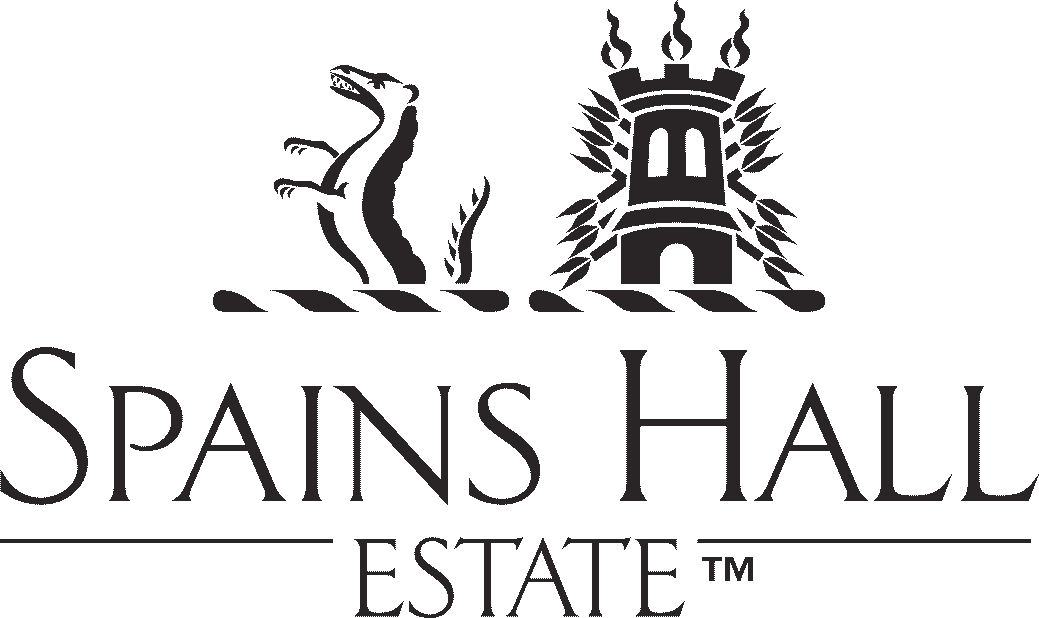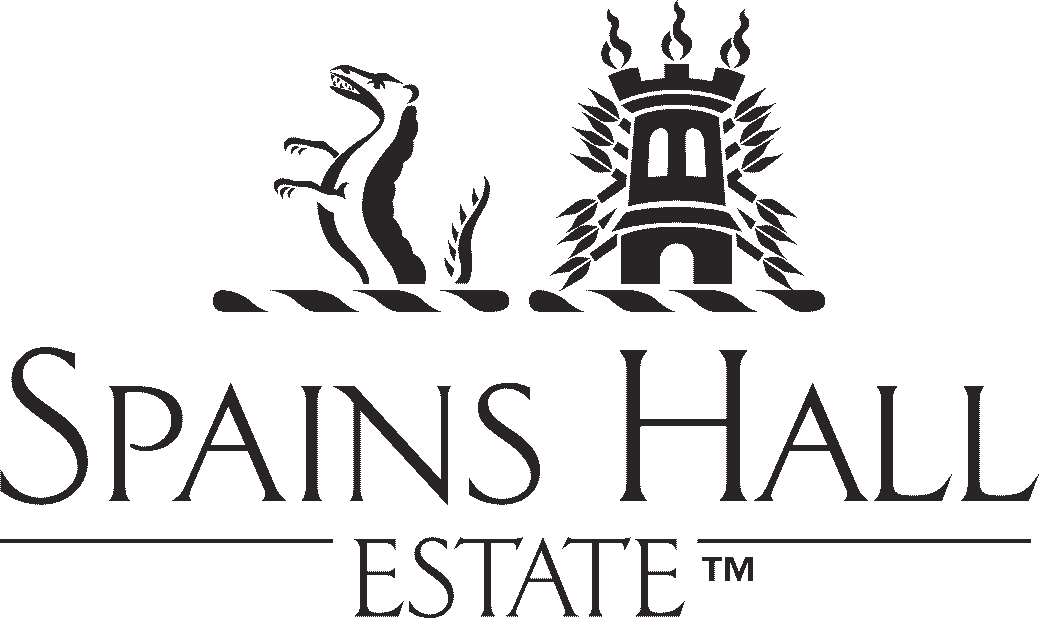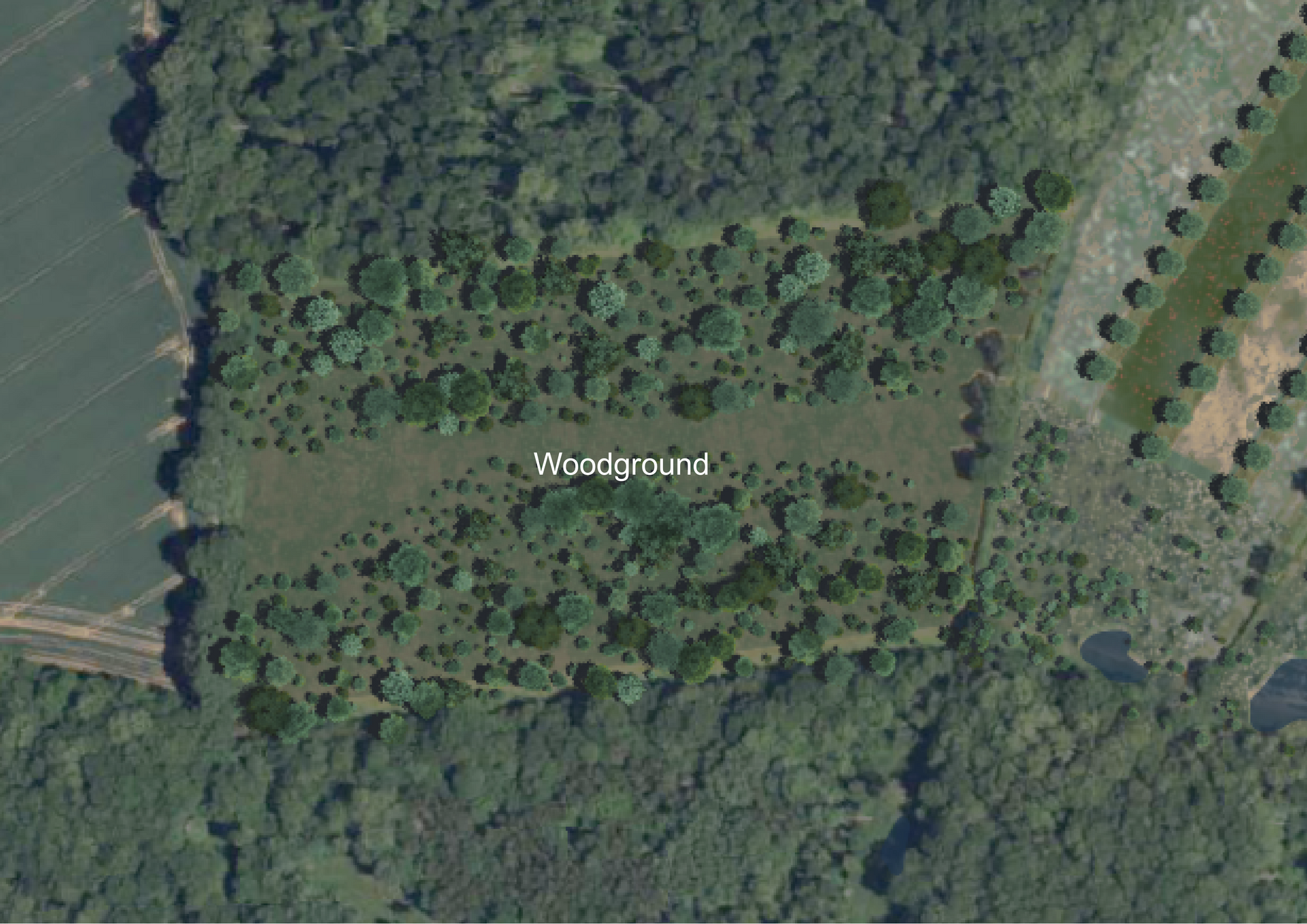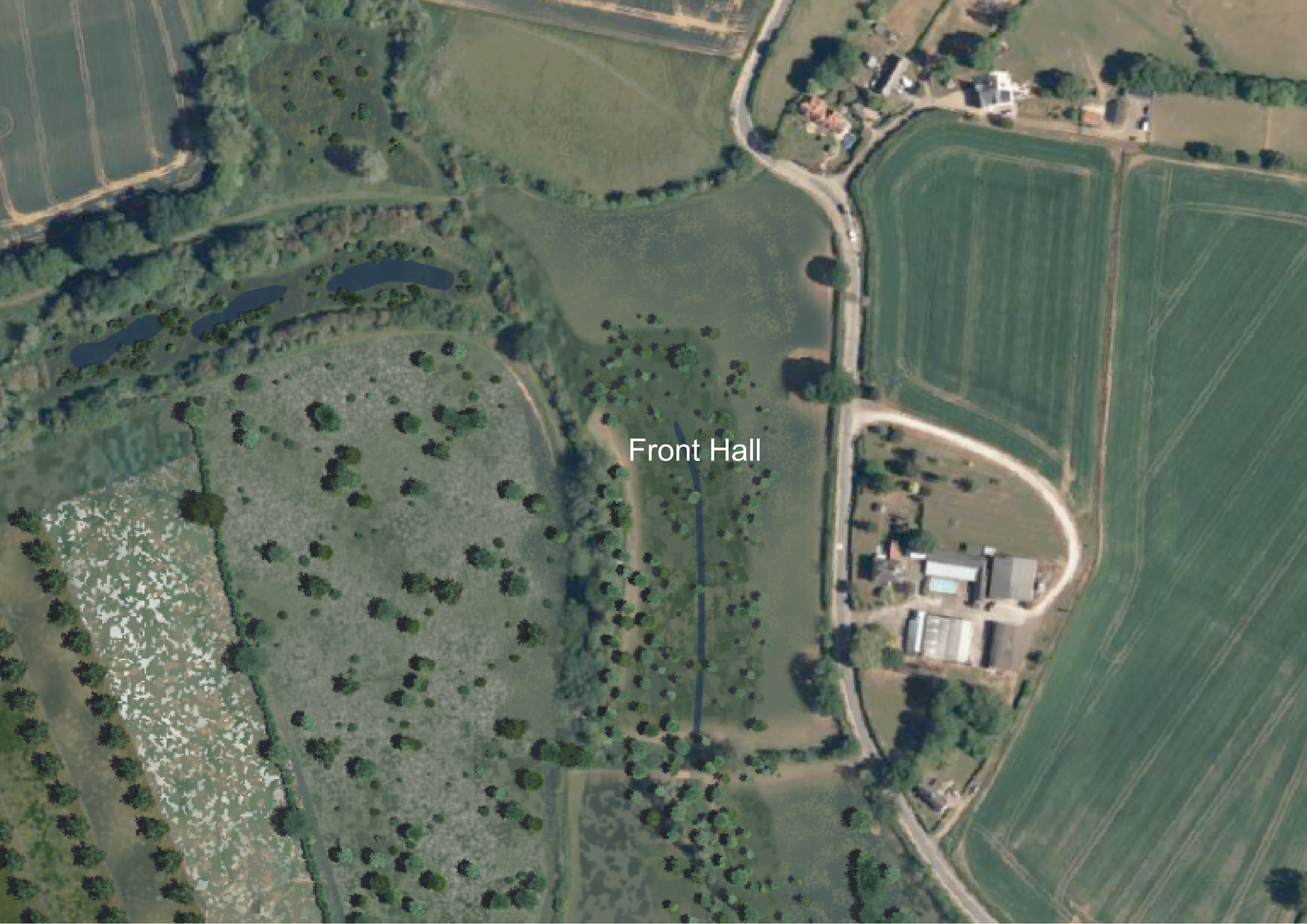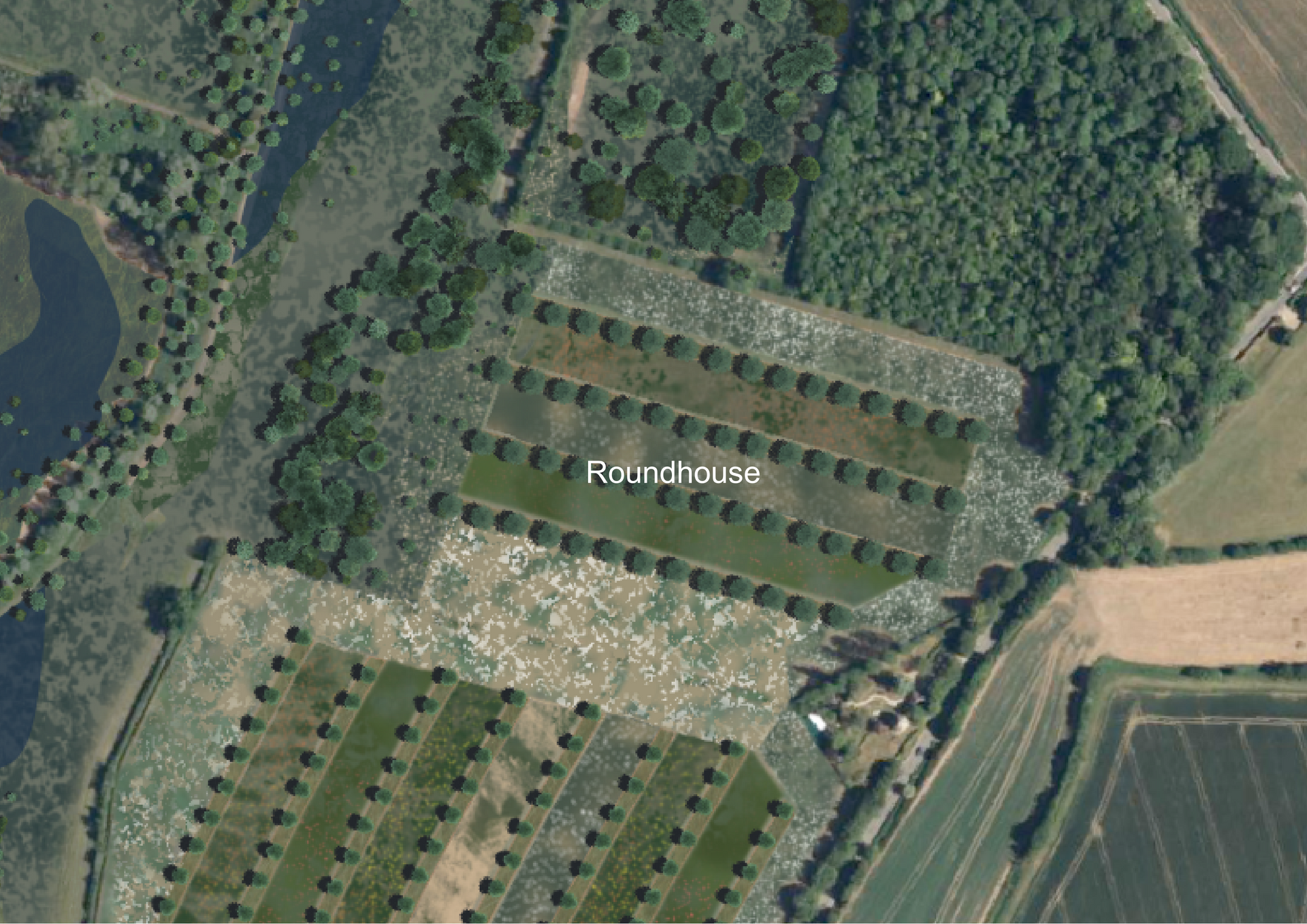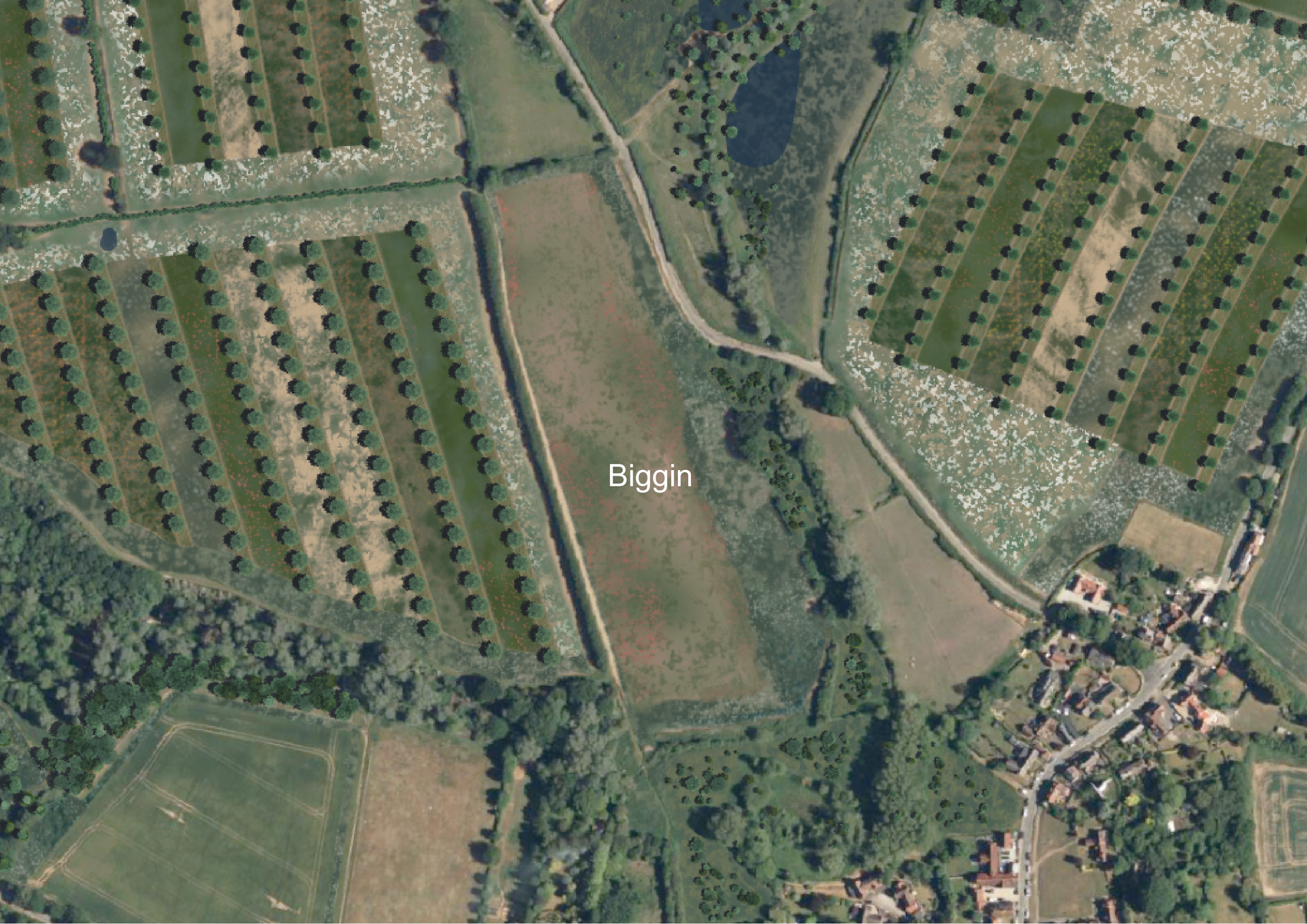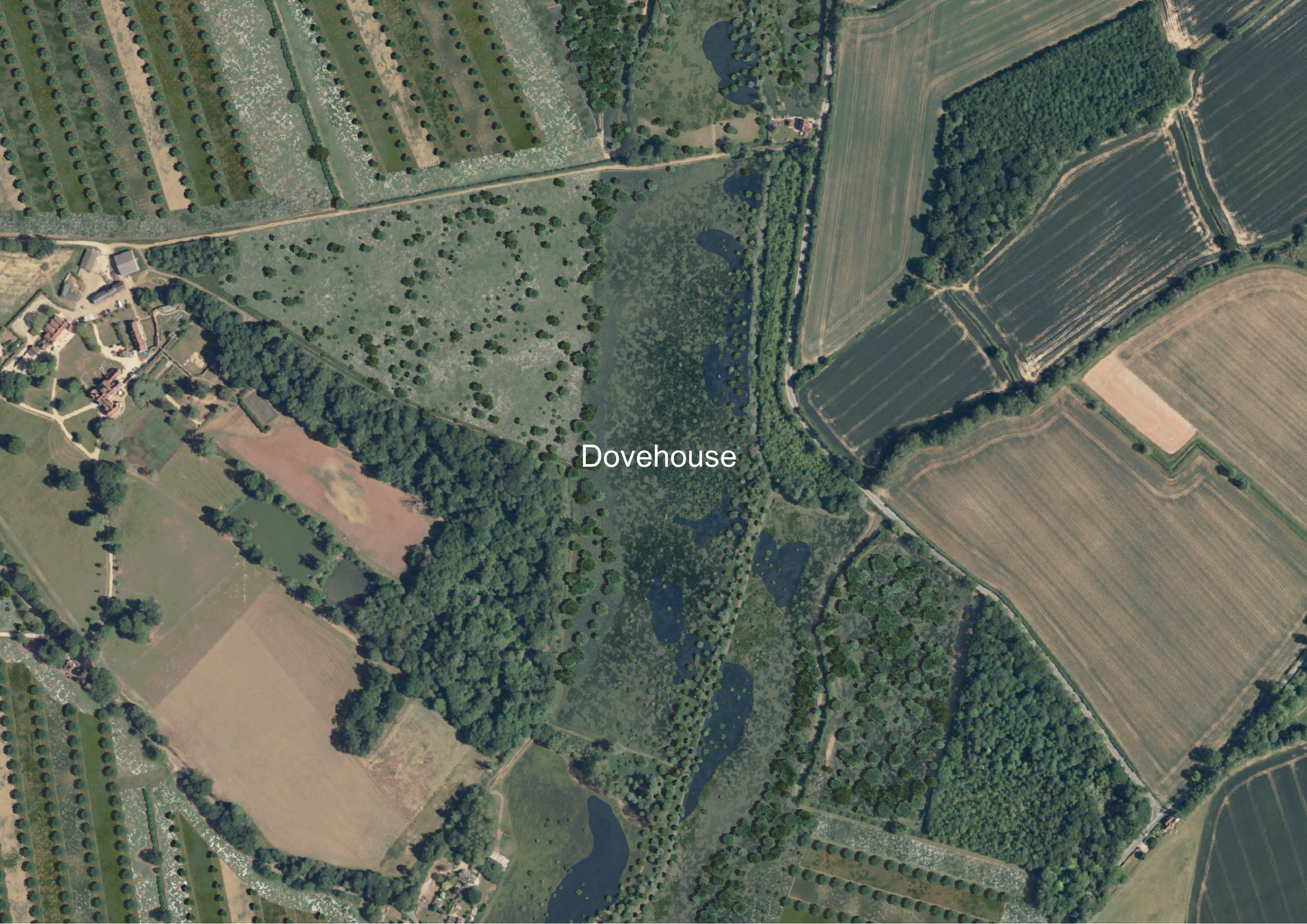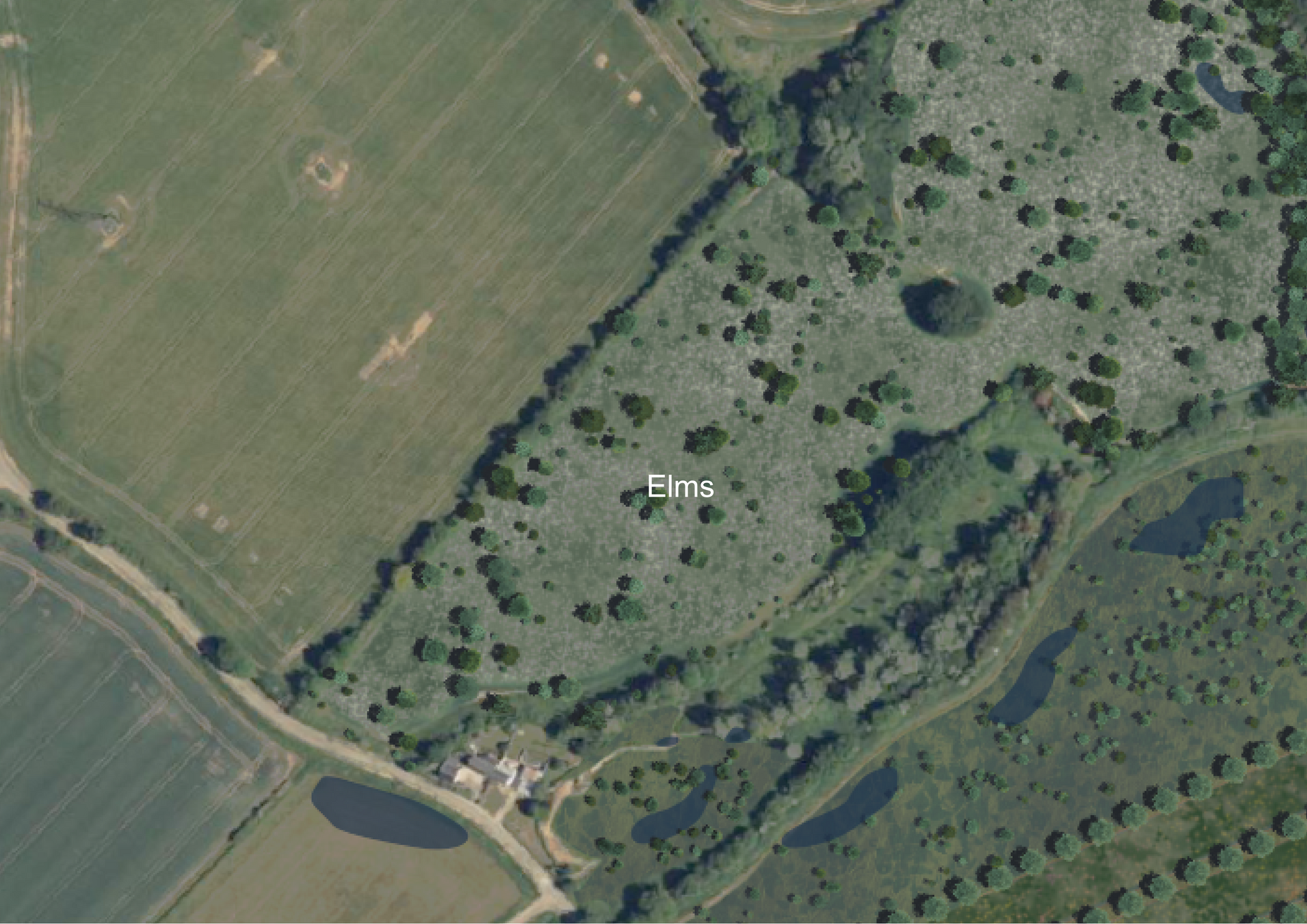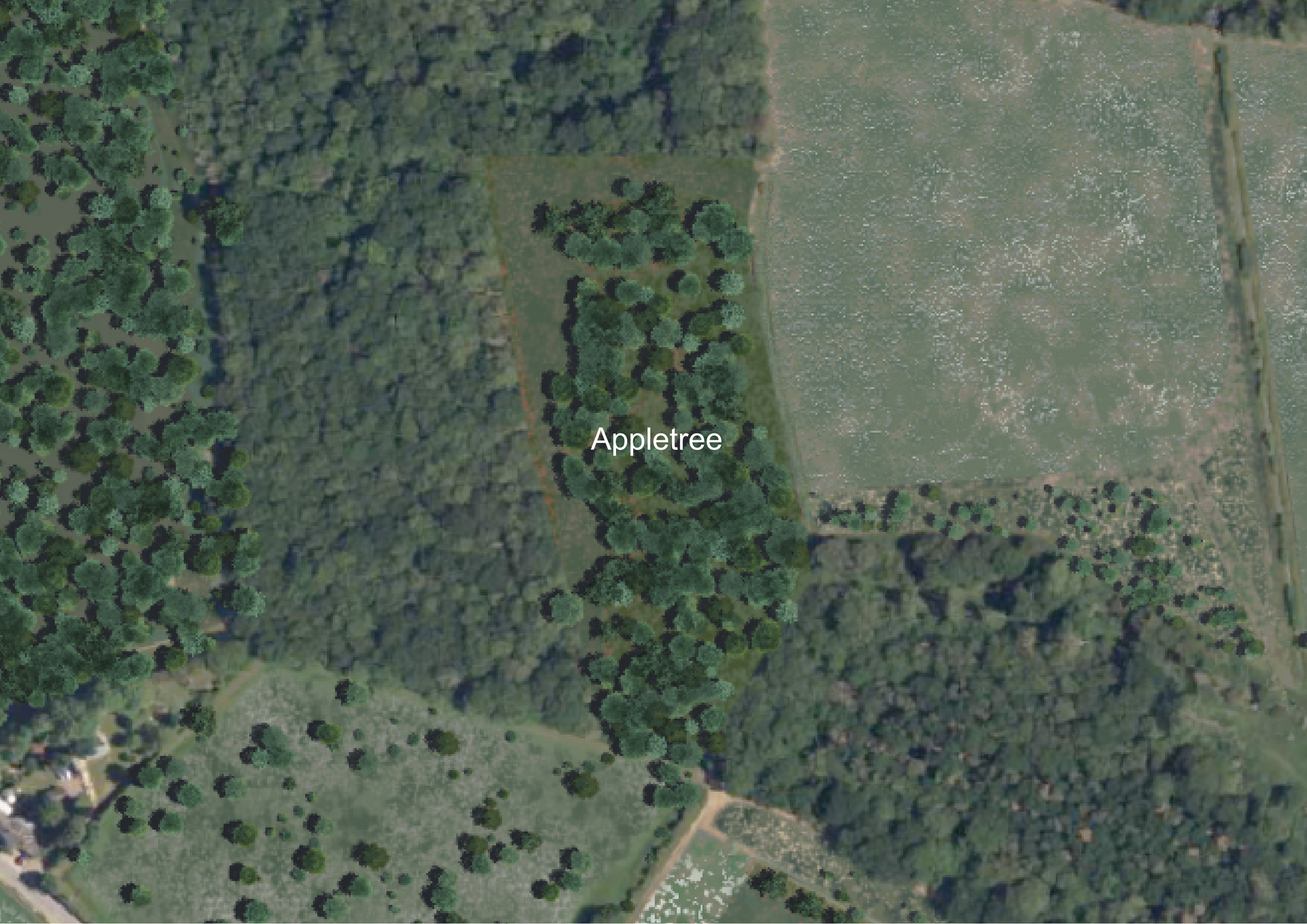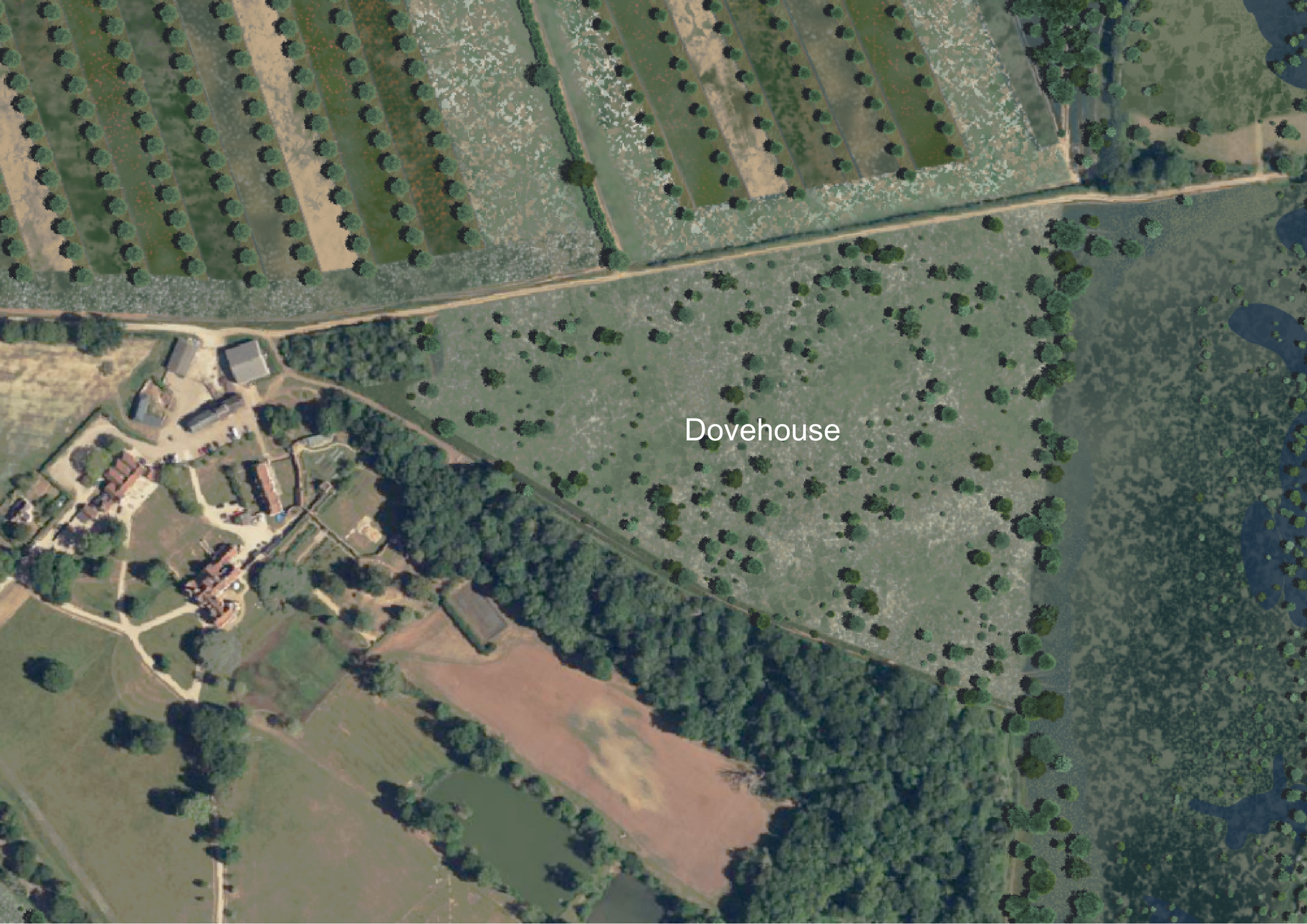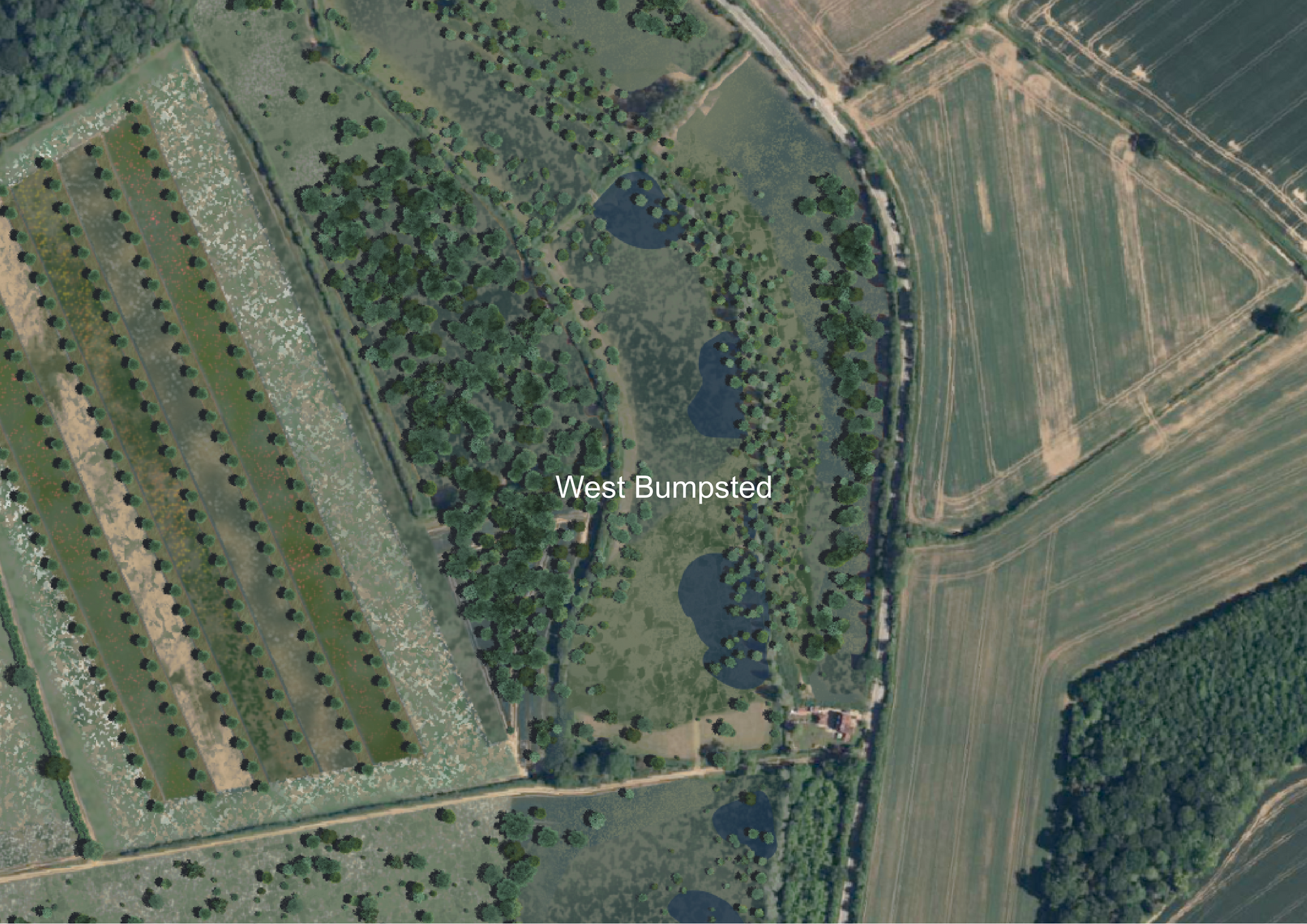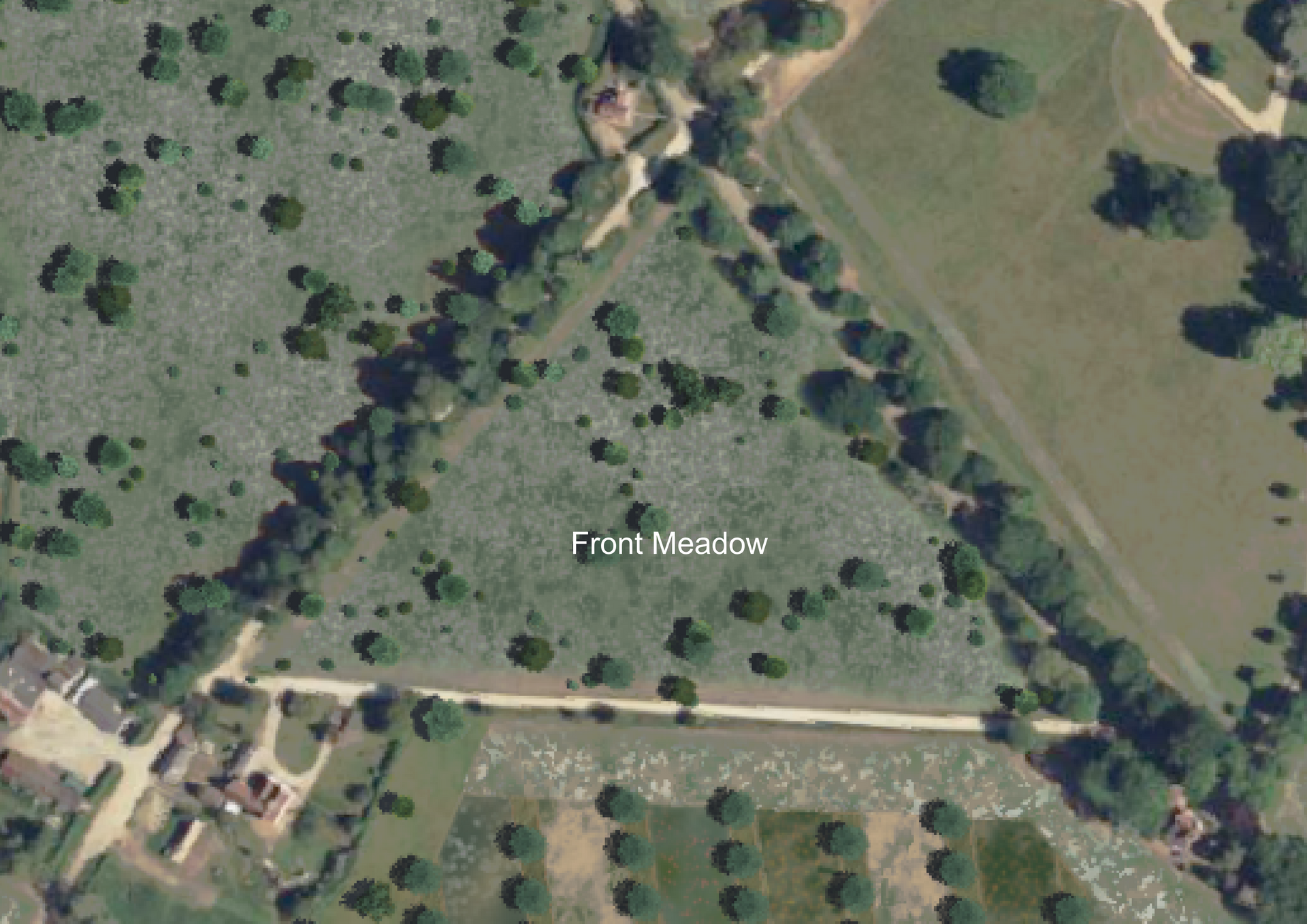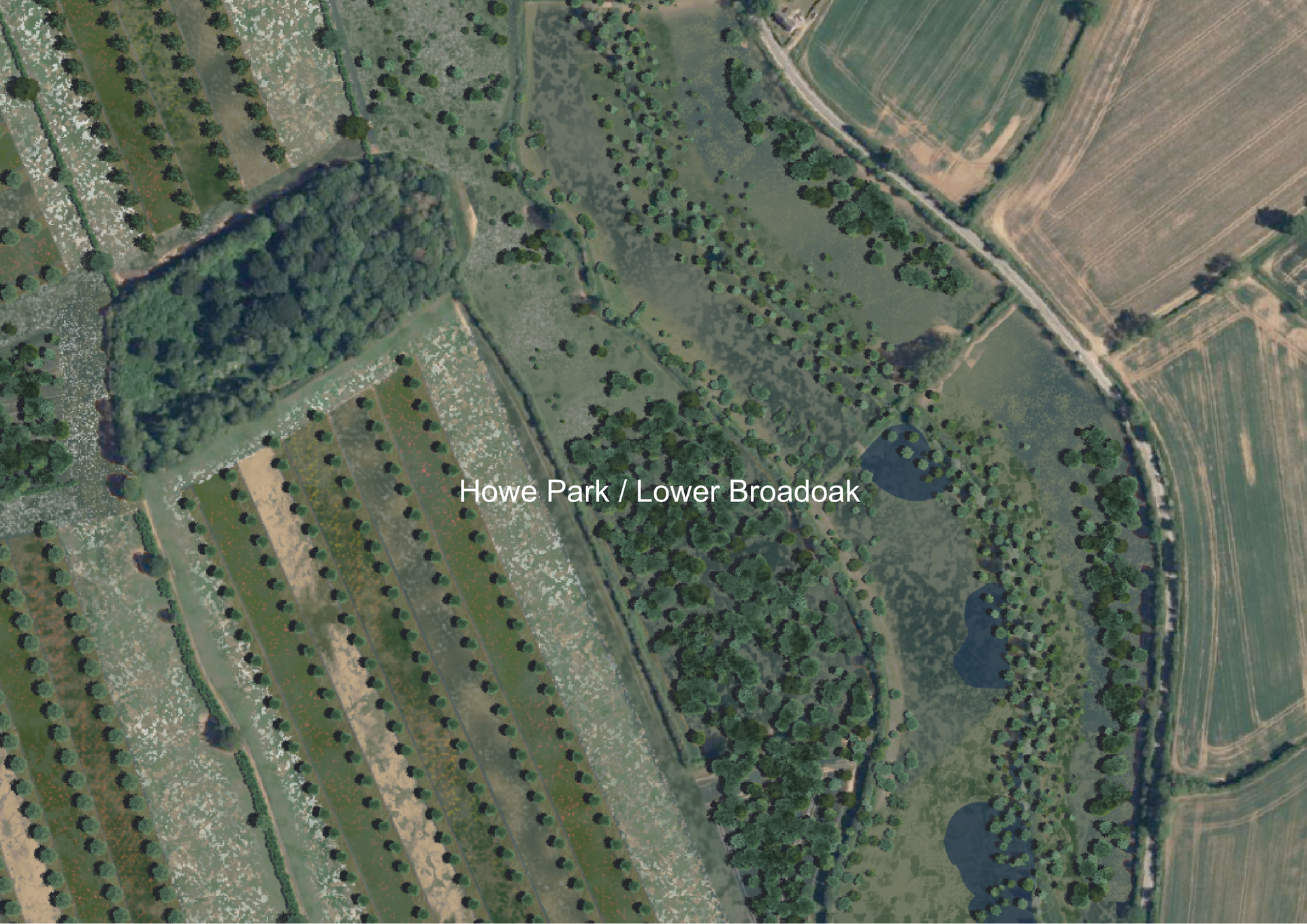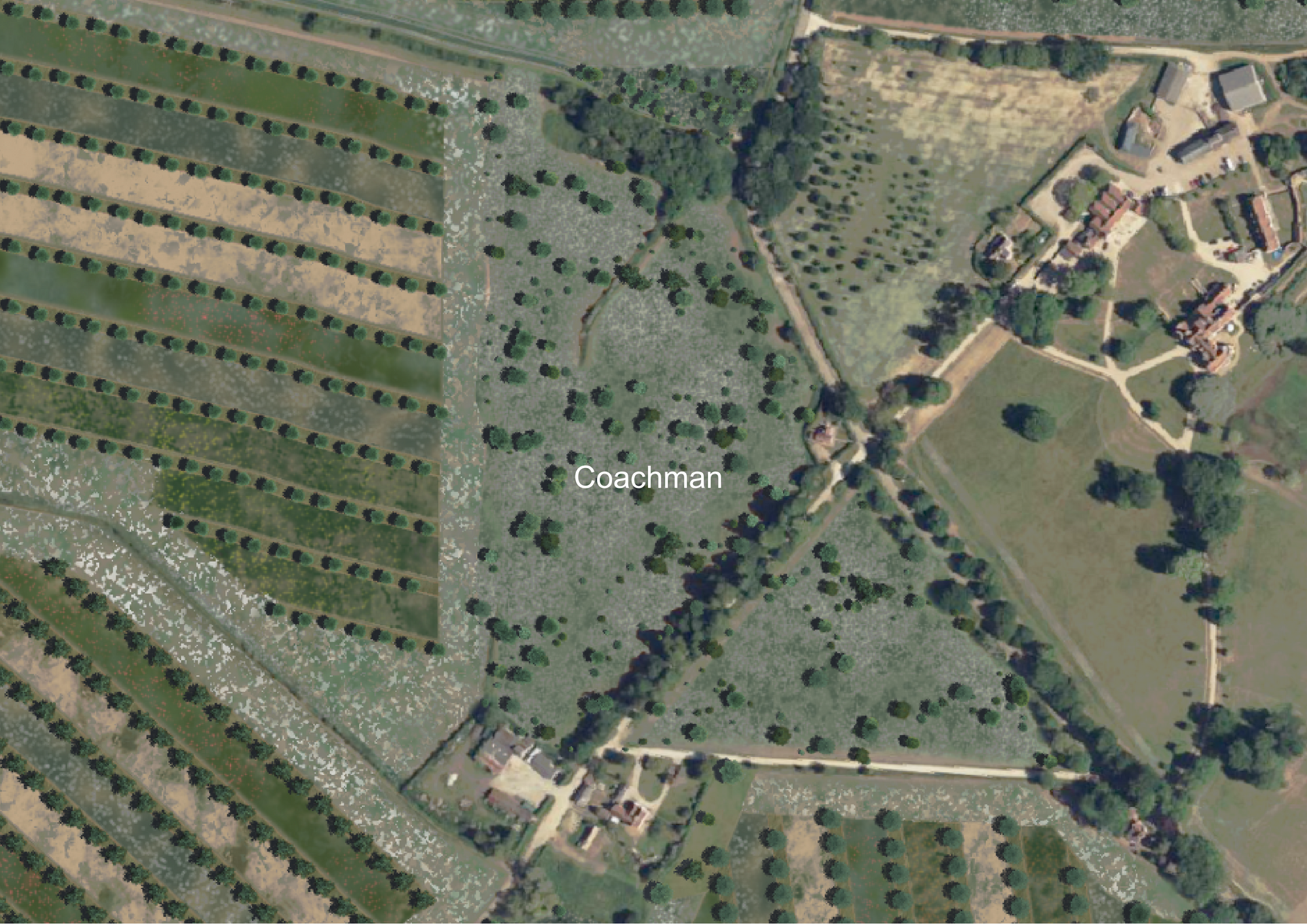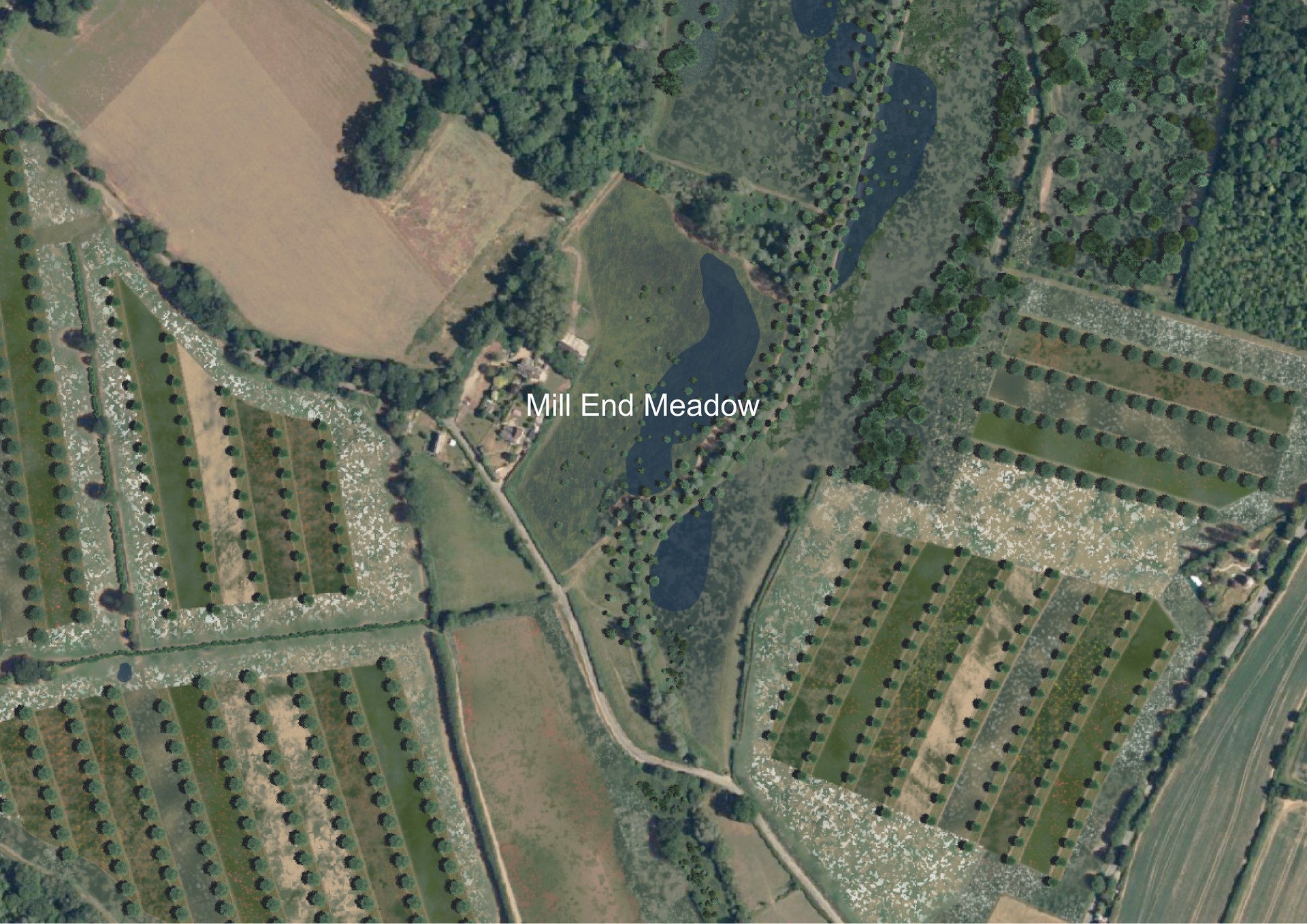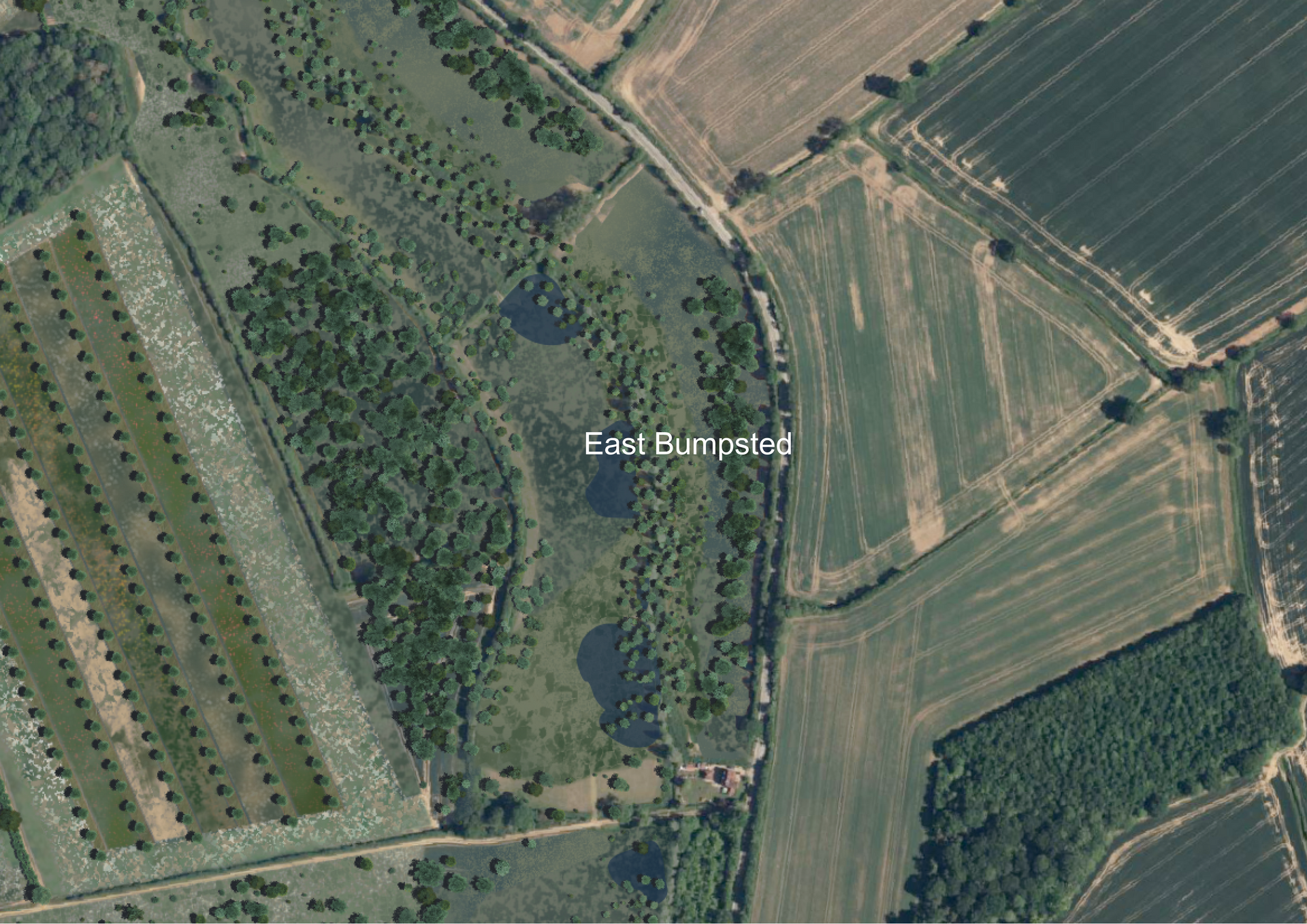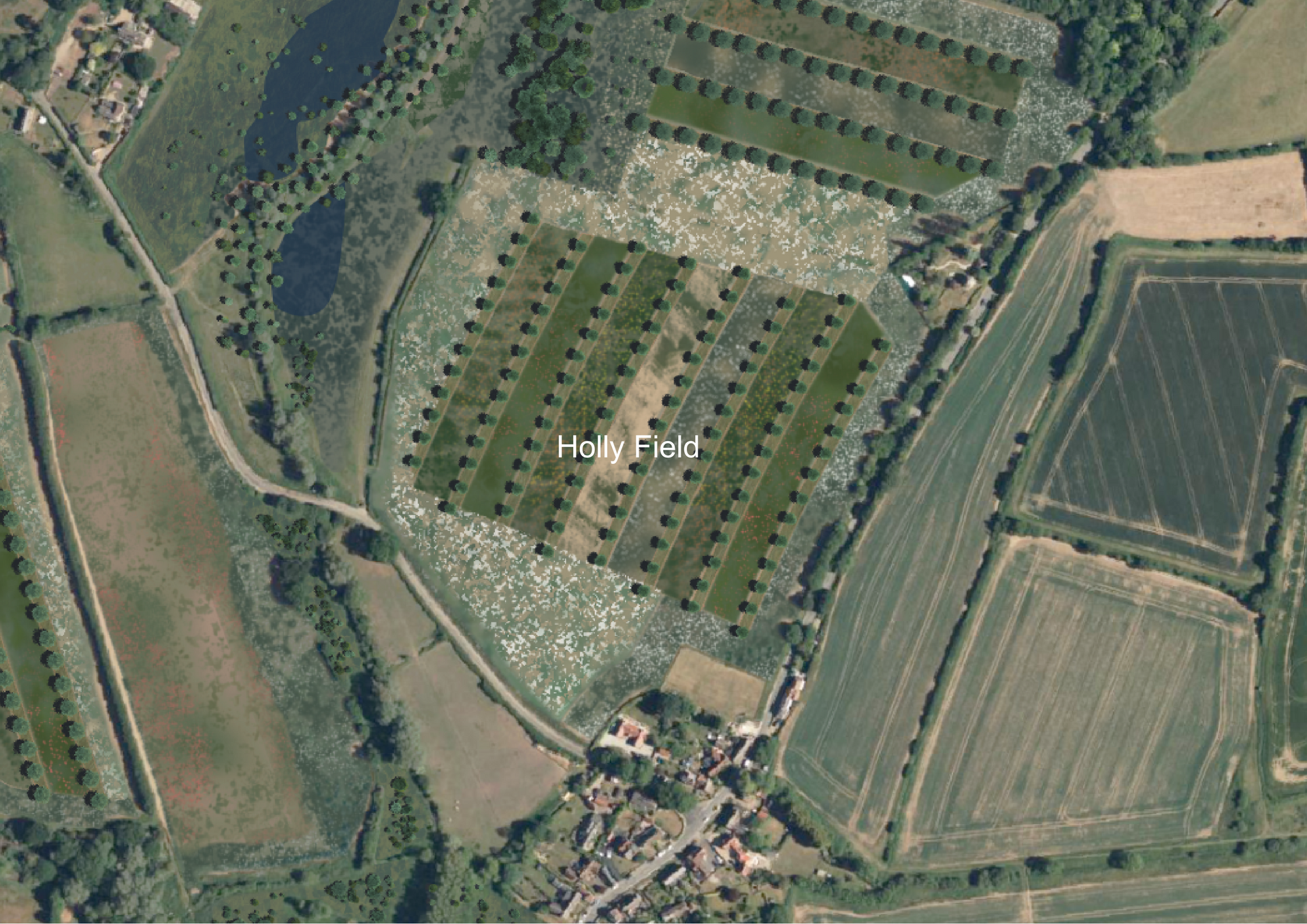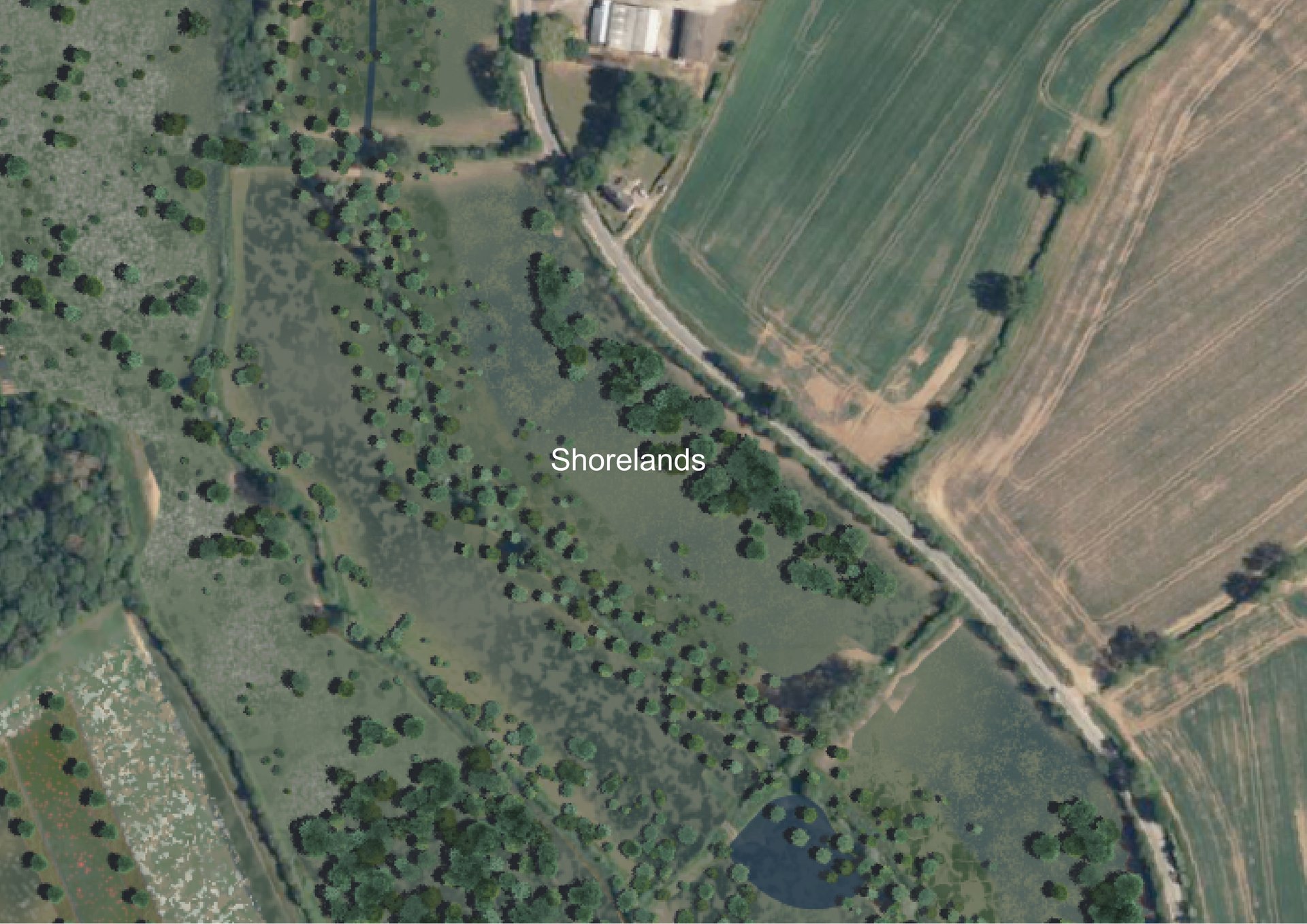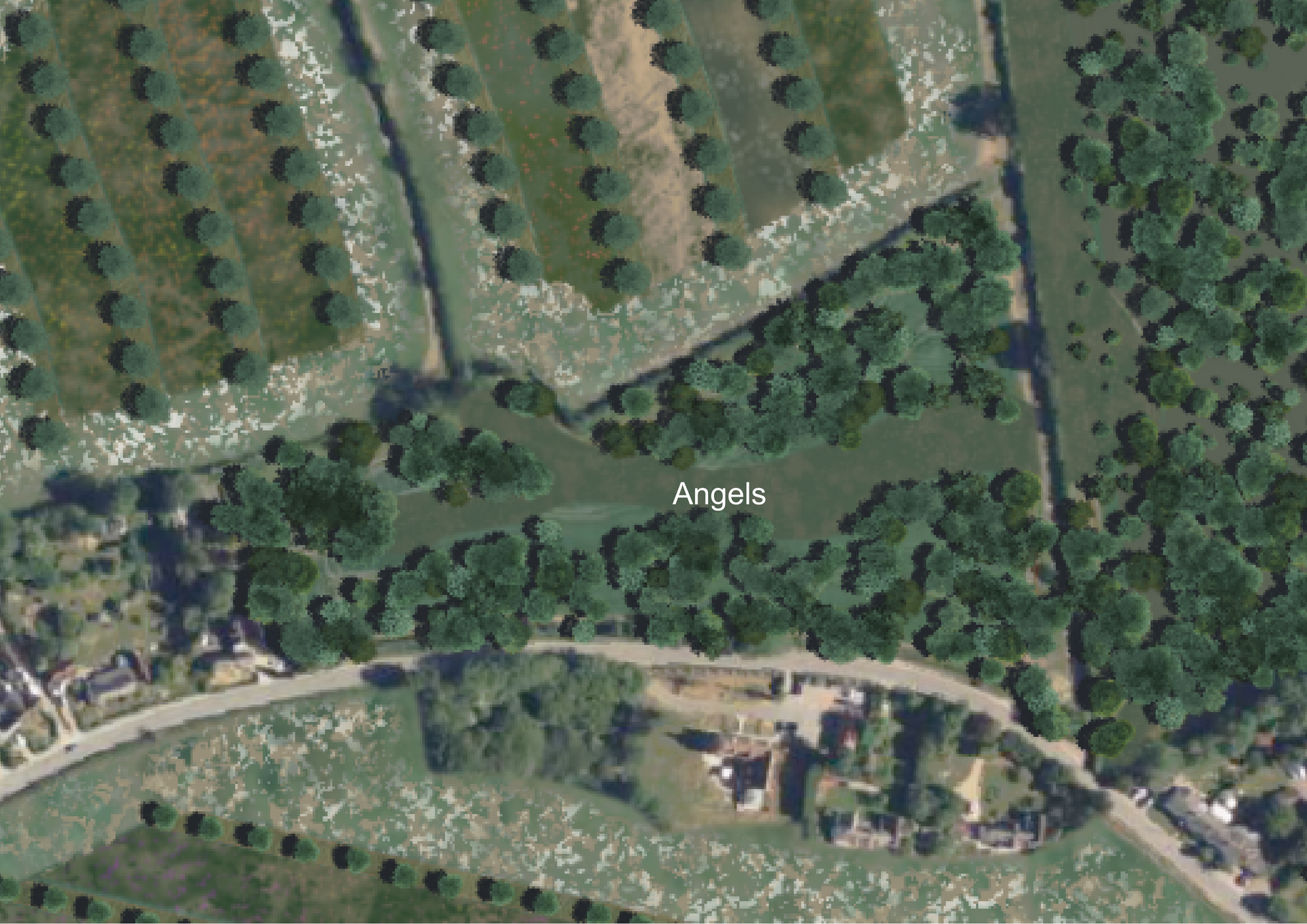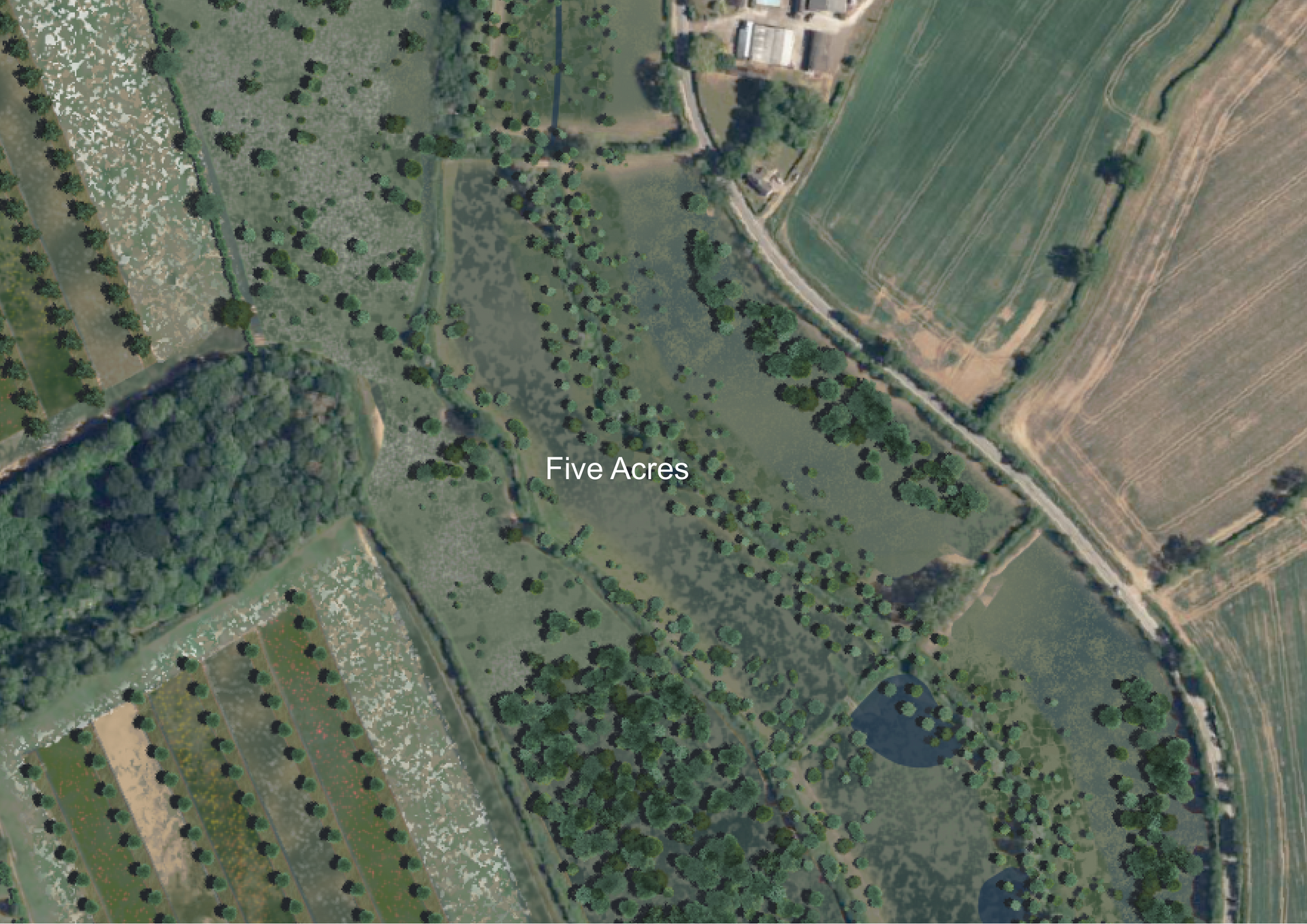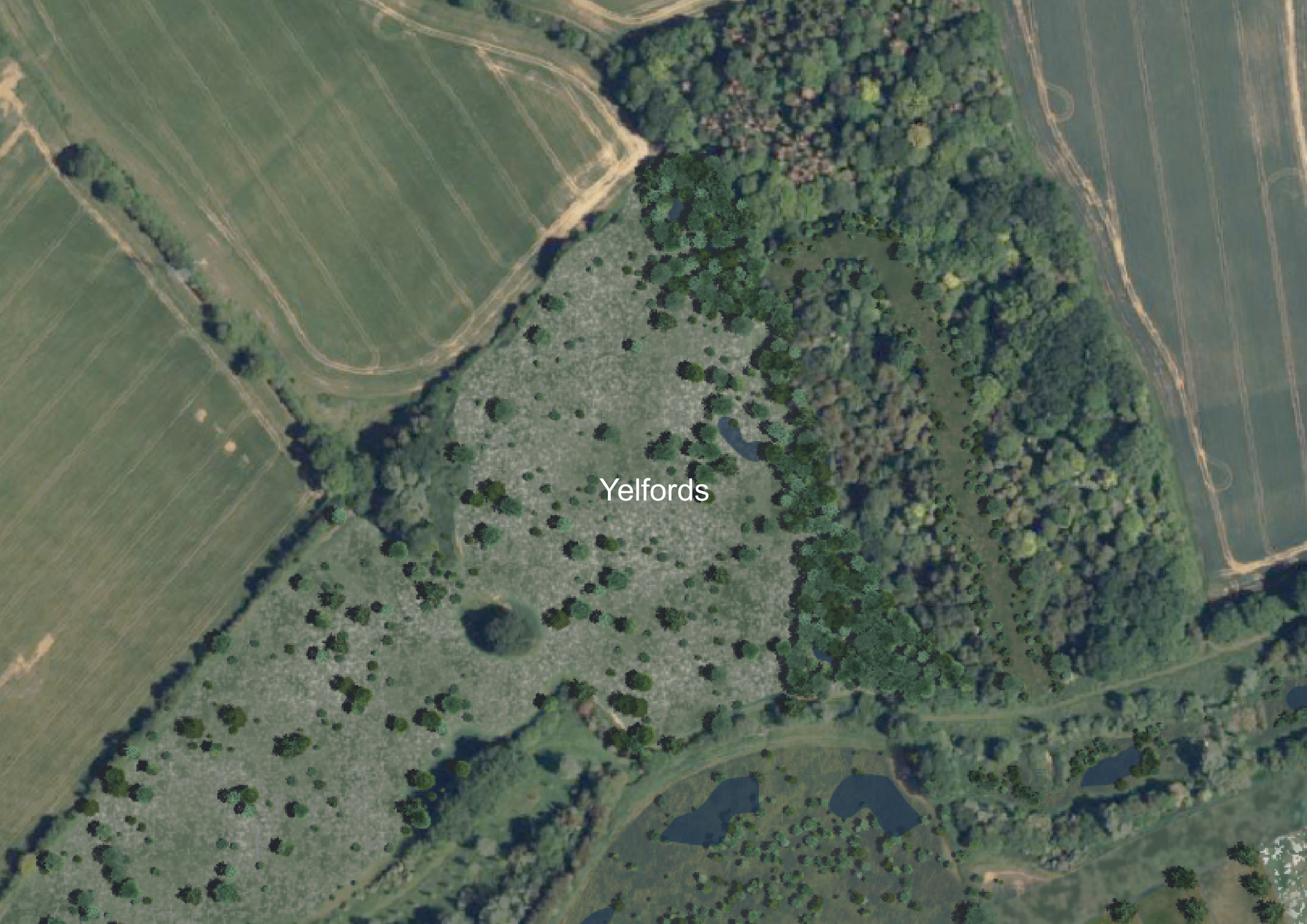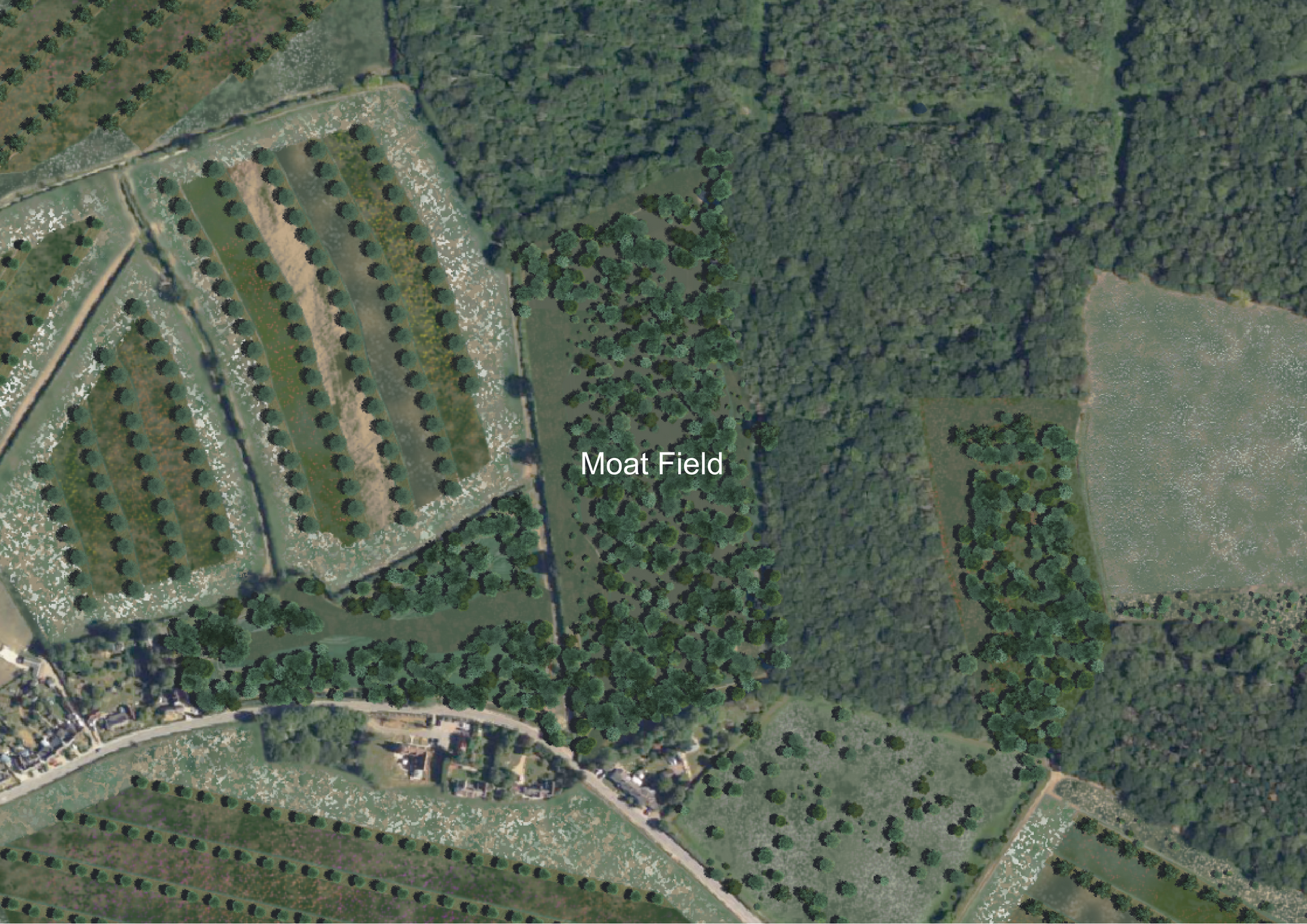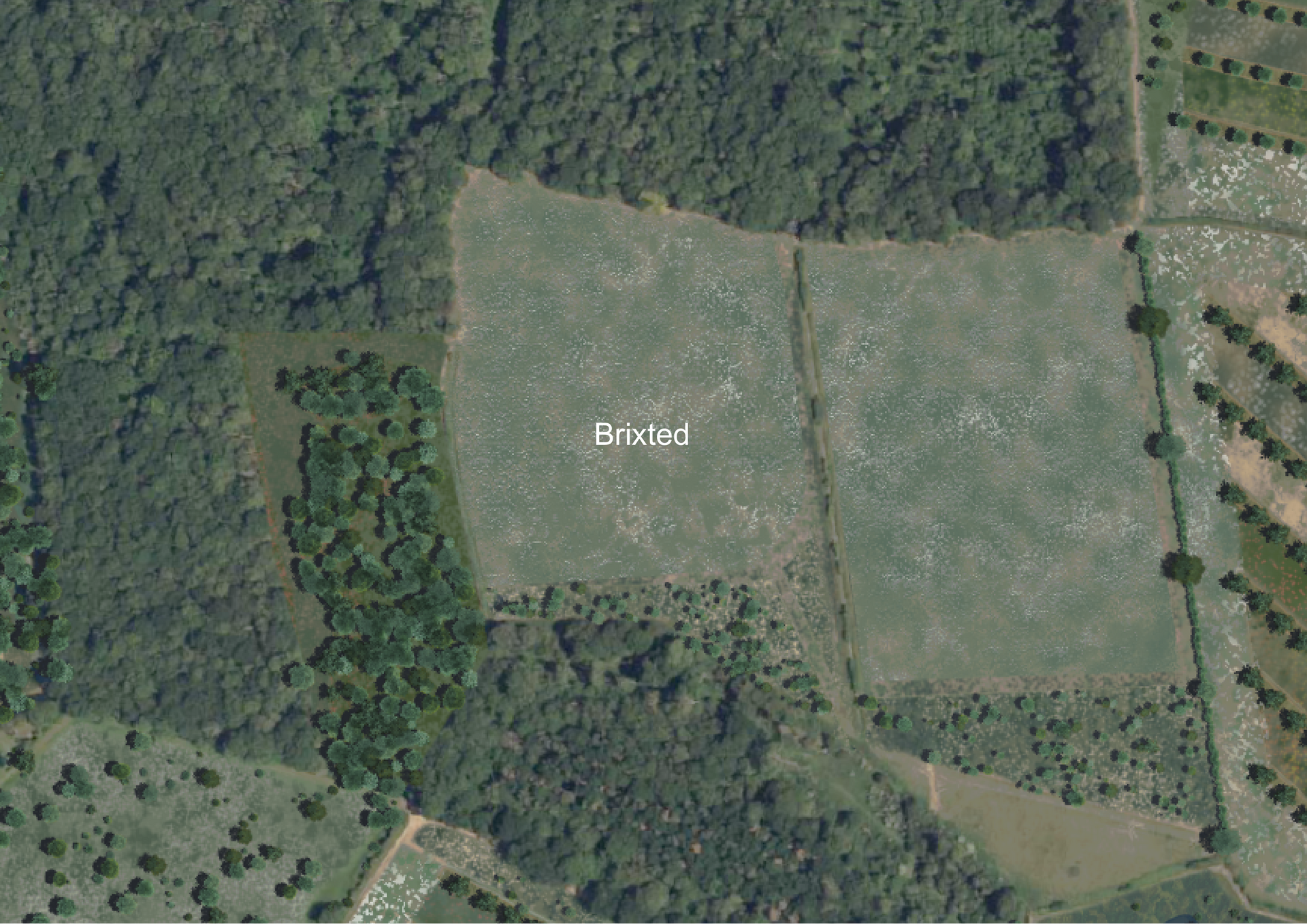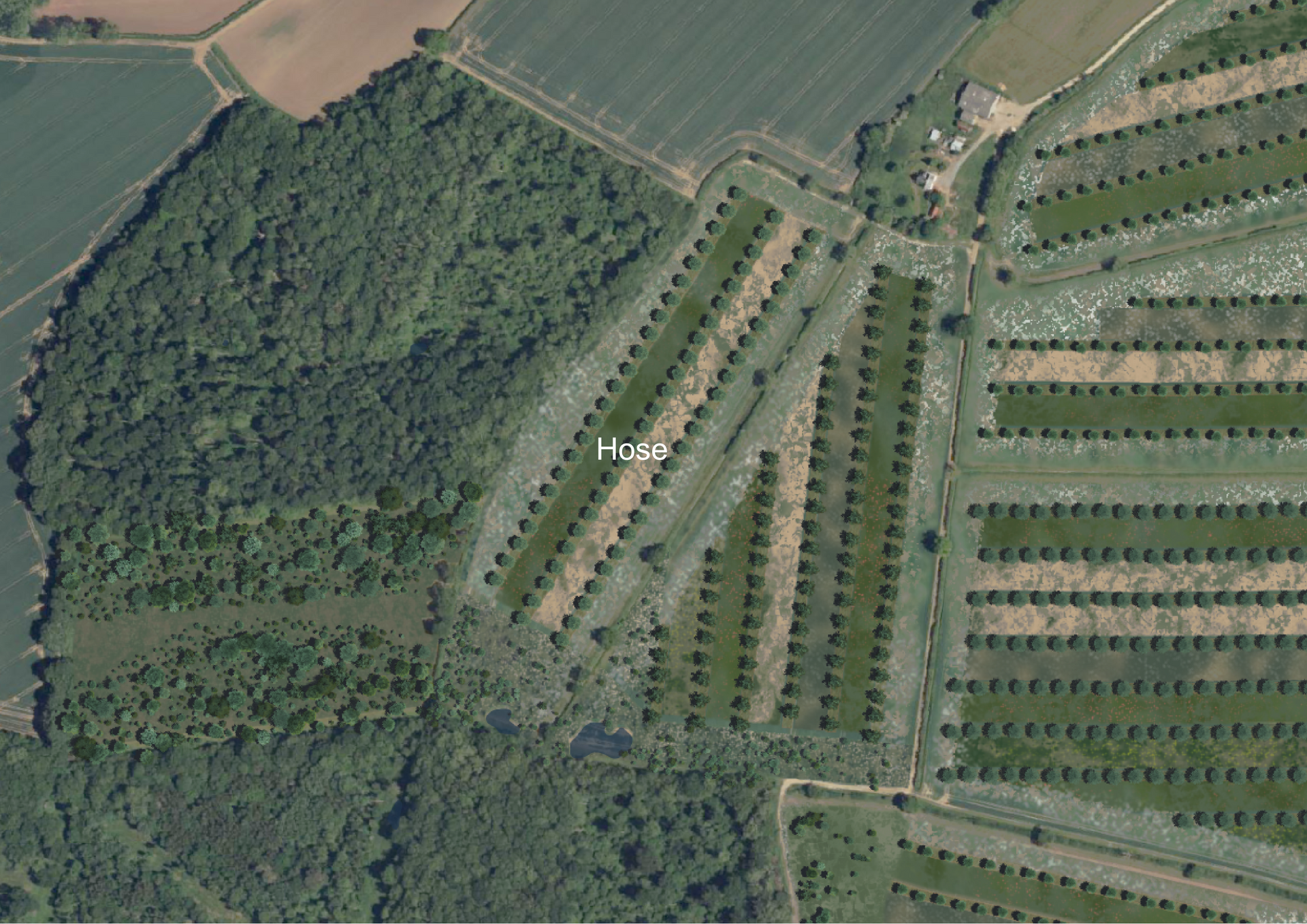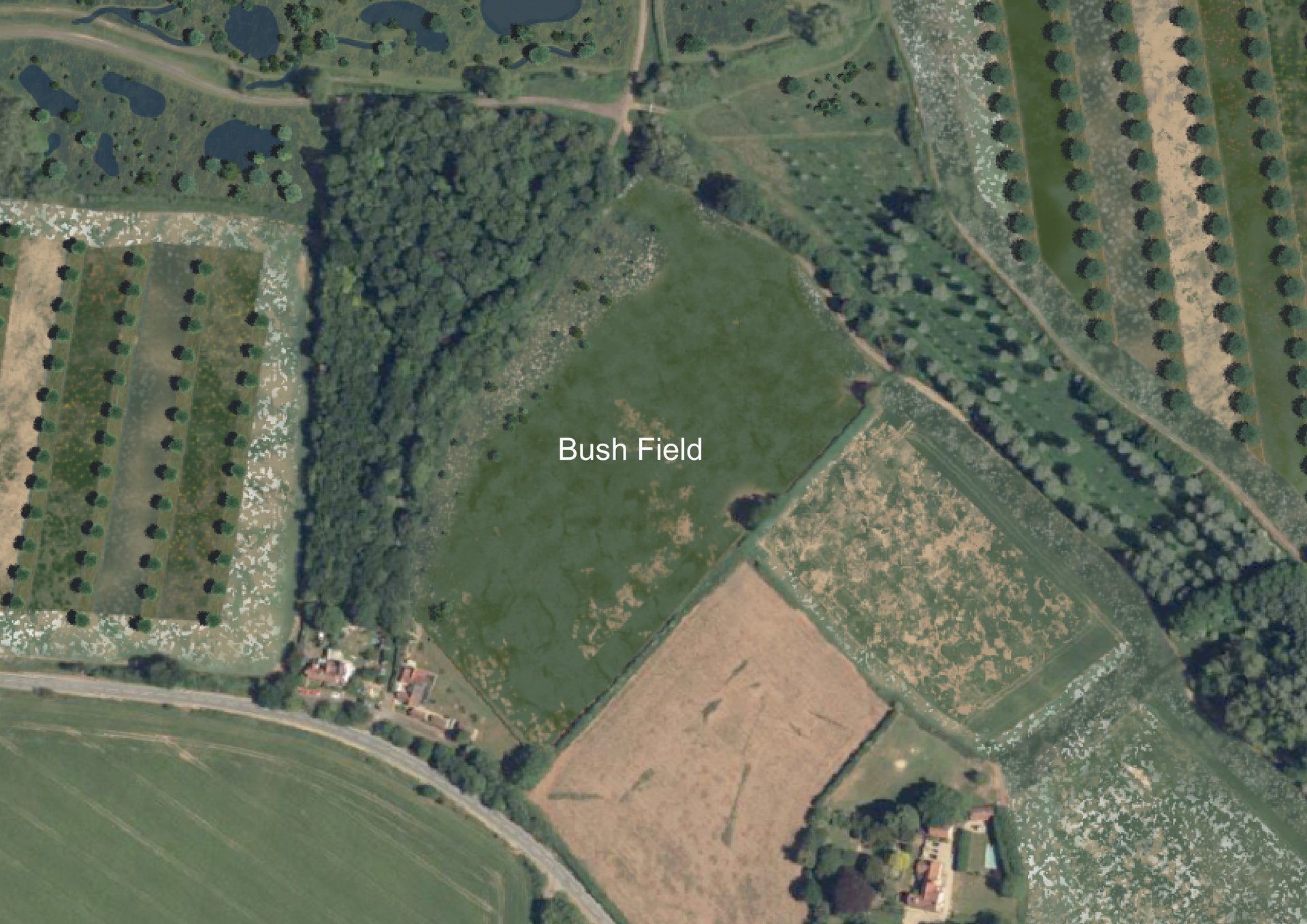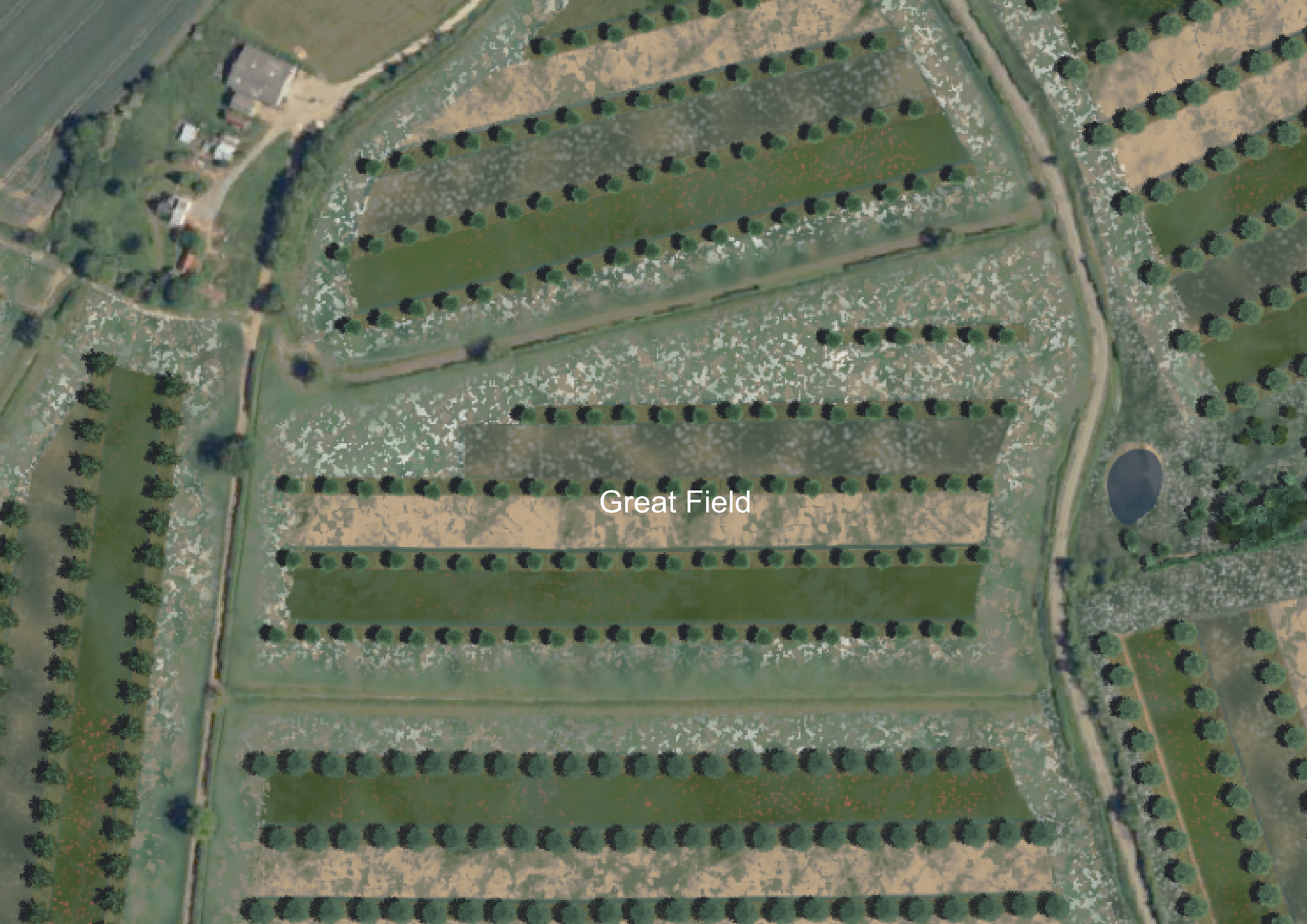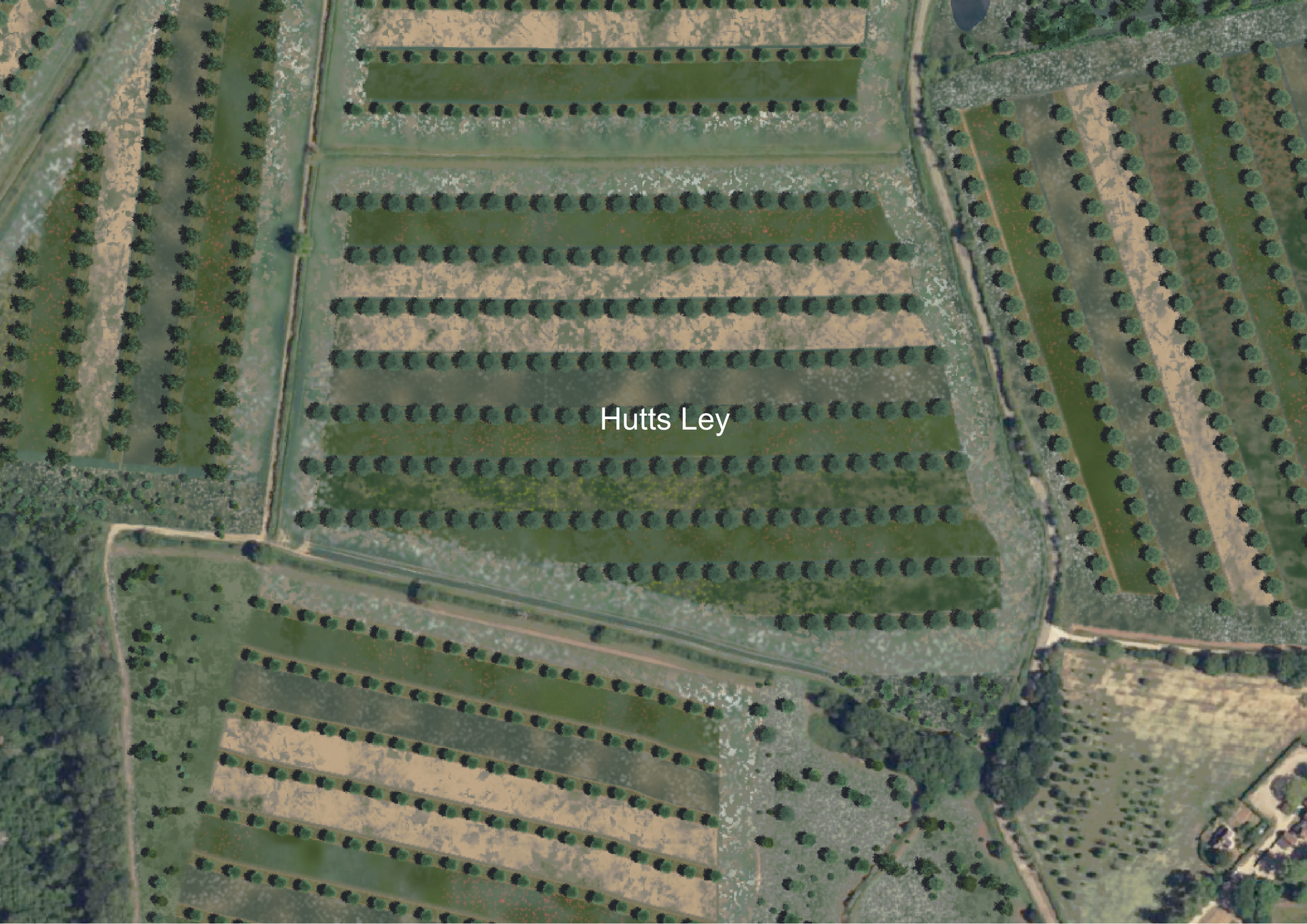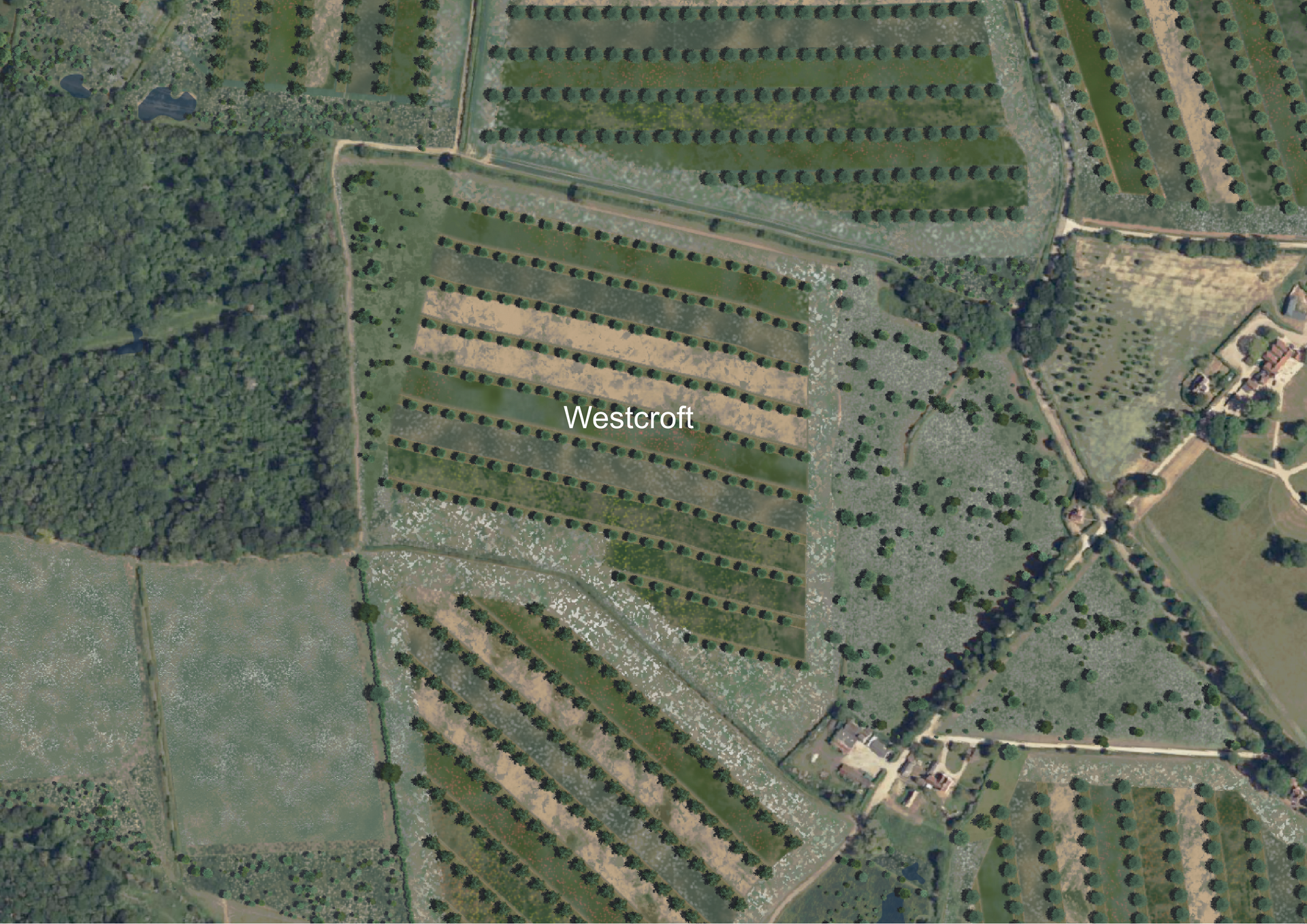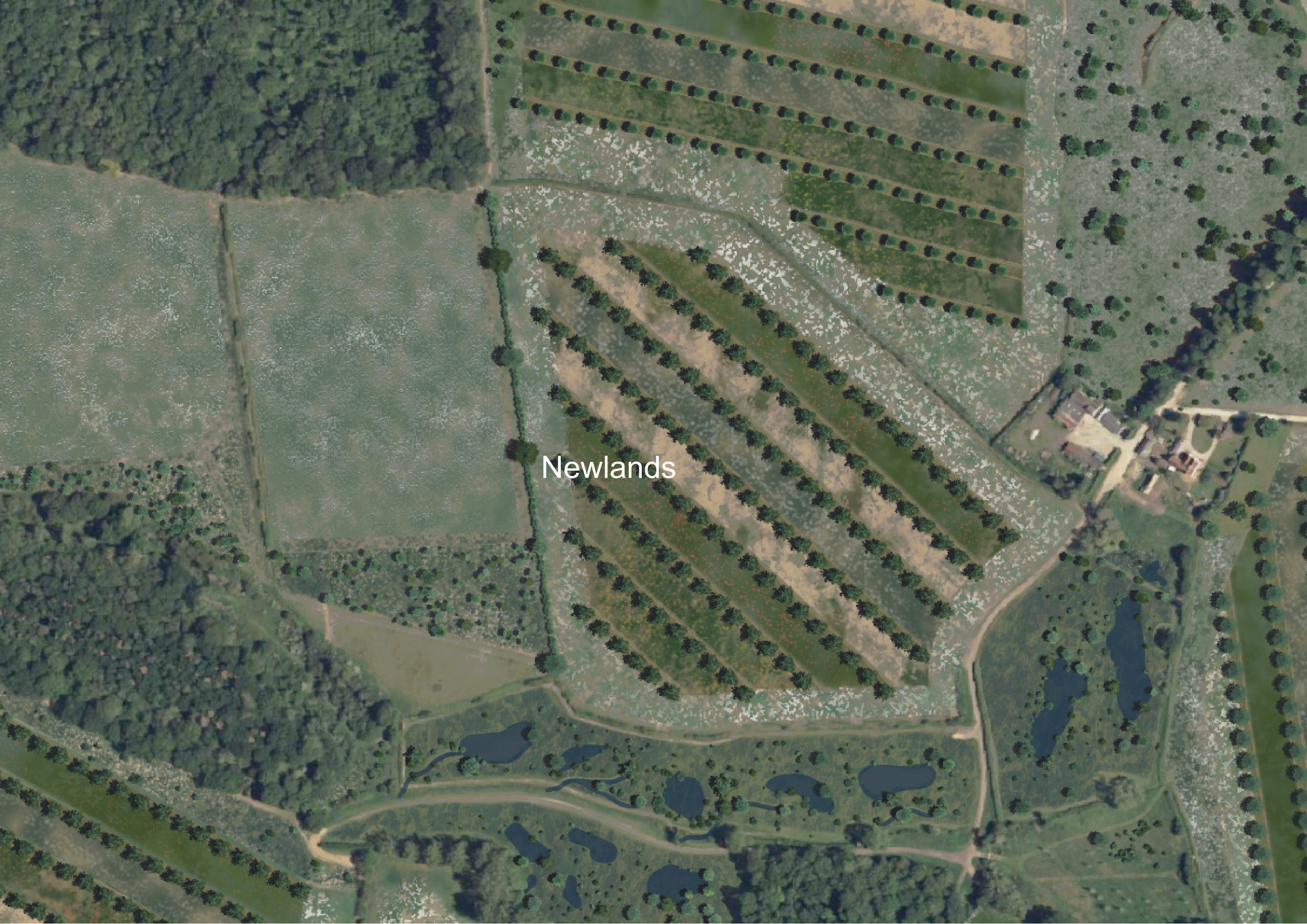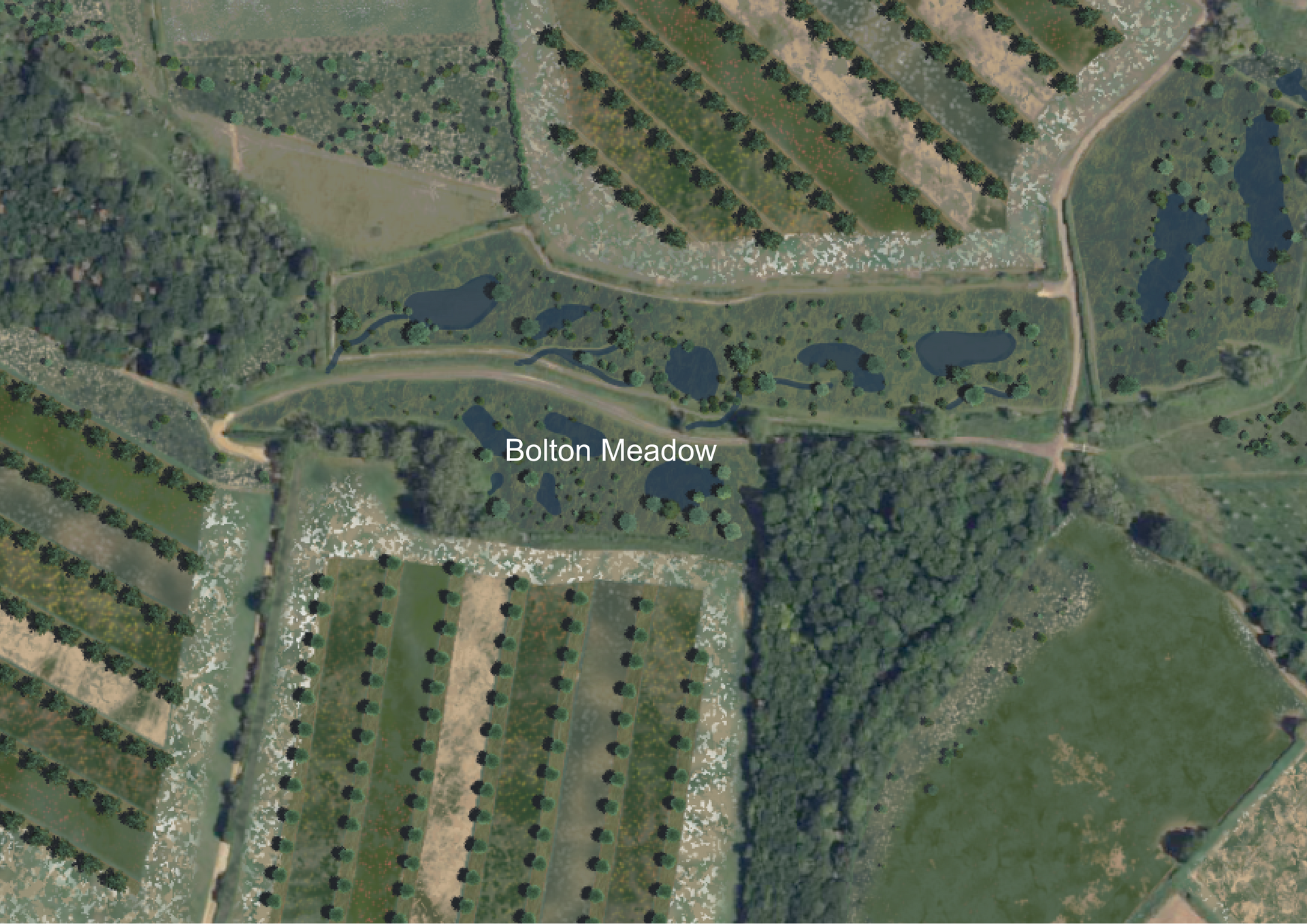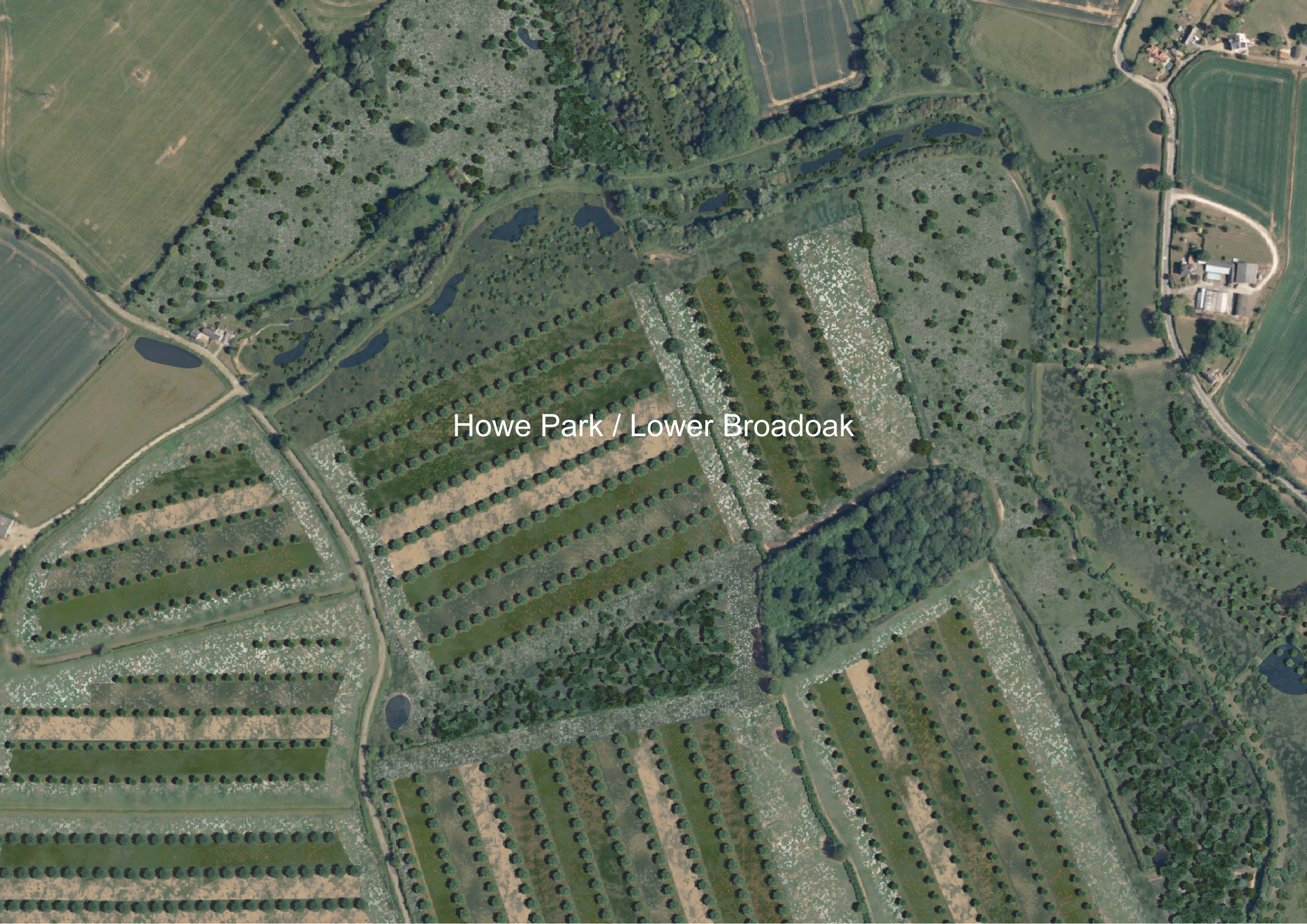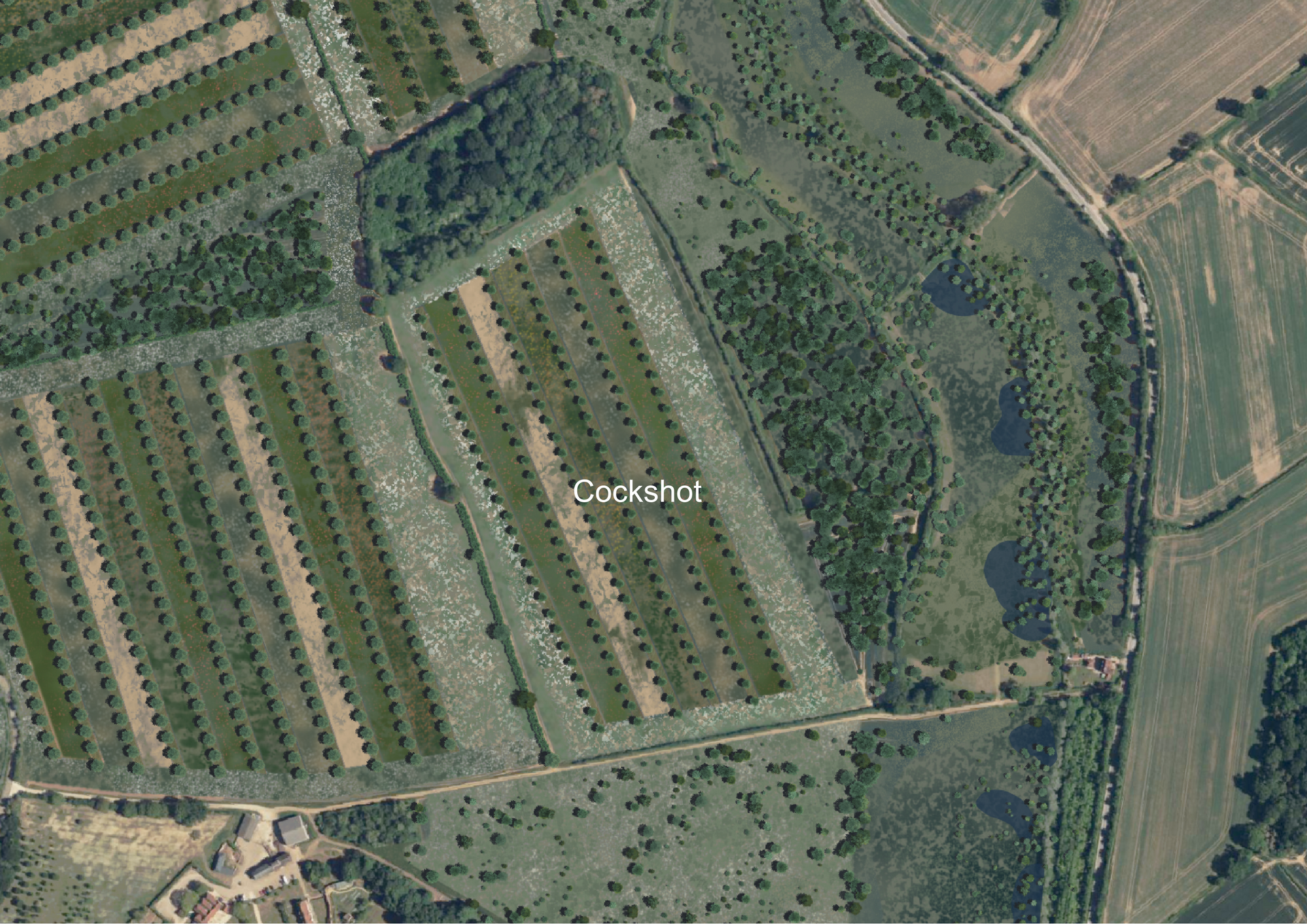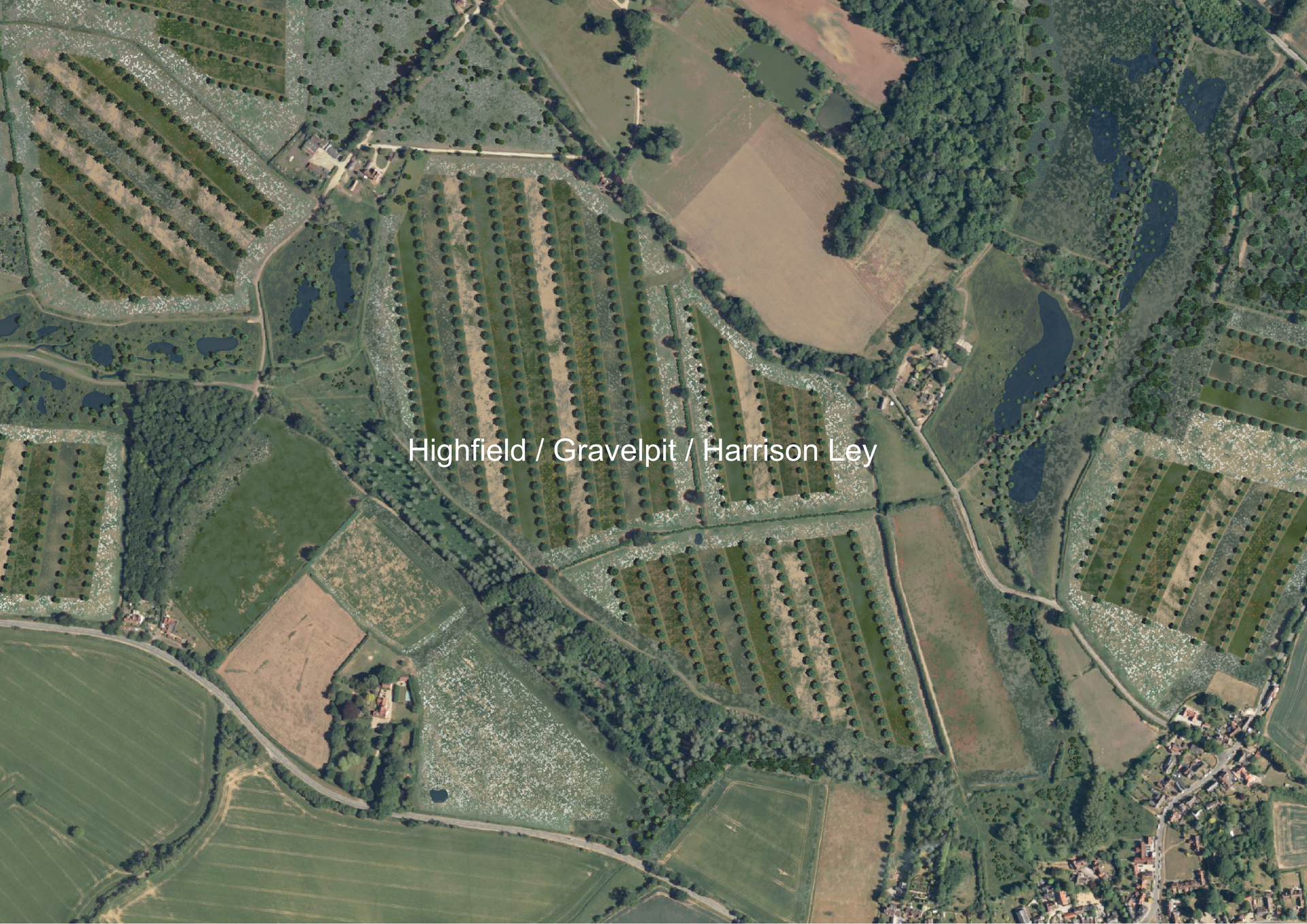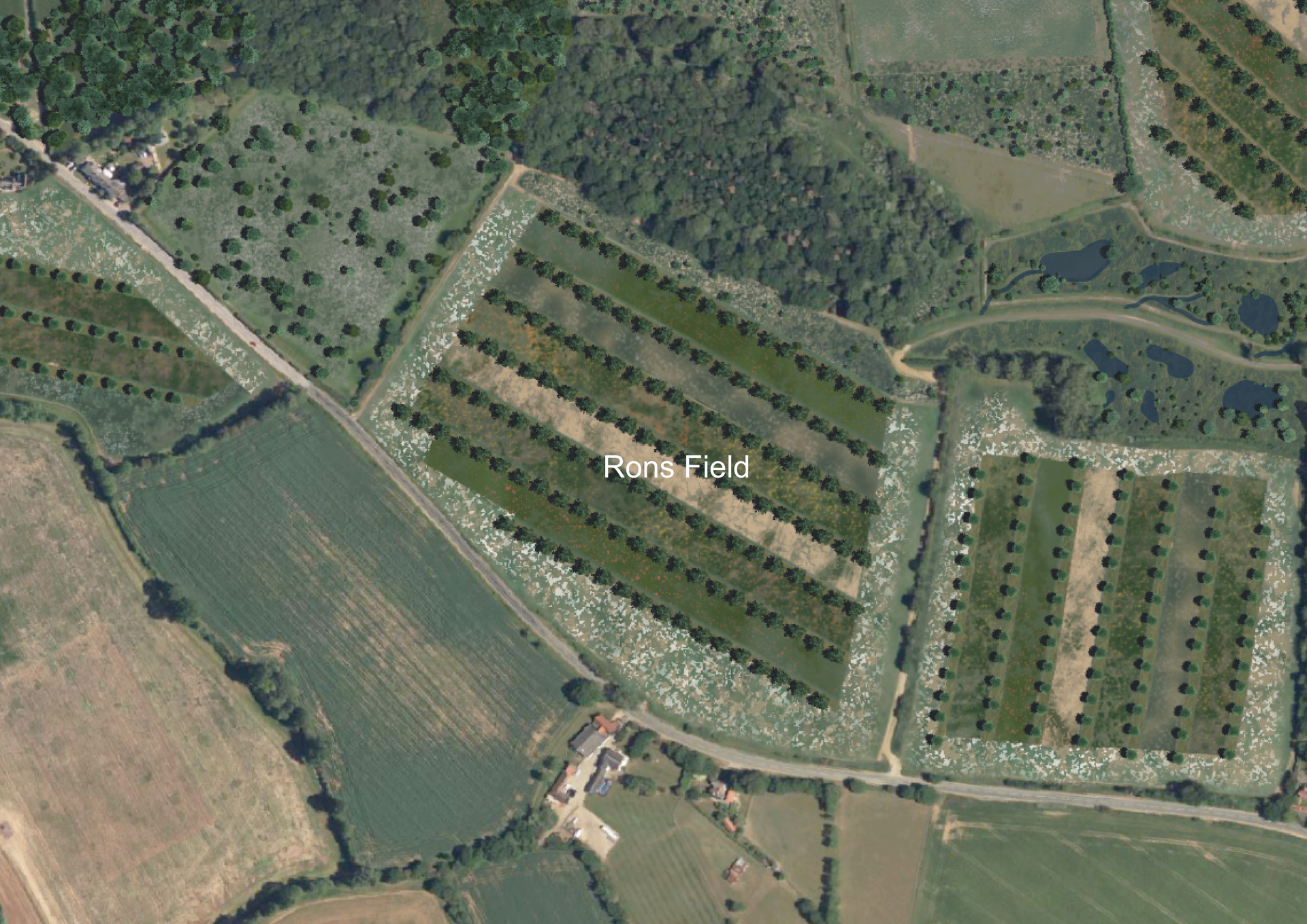ECOLOGICAL LANDSCAPE PLAN
This is a Before and After visualisation of what we believe the estate will look like once we've fully implemented the ecological landscape plan.
Use the slider below to explore the changes.
We've split up our large Biodiversity recovery project into field-sized chucks to help you get into the detail of what we are doing.
Click on a field below the large map to learn more.
We have dedicated areas within the Ecological Landscape Plan for Biodiversity Net Gain off-site provision, so if you need to purchase BNG Units now or in the future please contact us
Agroforestry
Learn moreWilding
Learn moreCarbon removal
Learn moreBiodiversity recovery
Learn moreFlood risk management
Learn moreNatural Capital
Learn more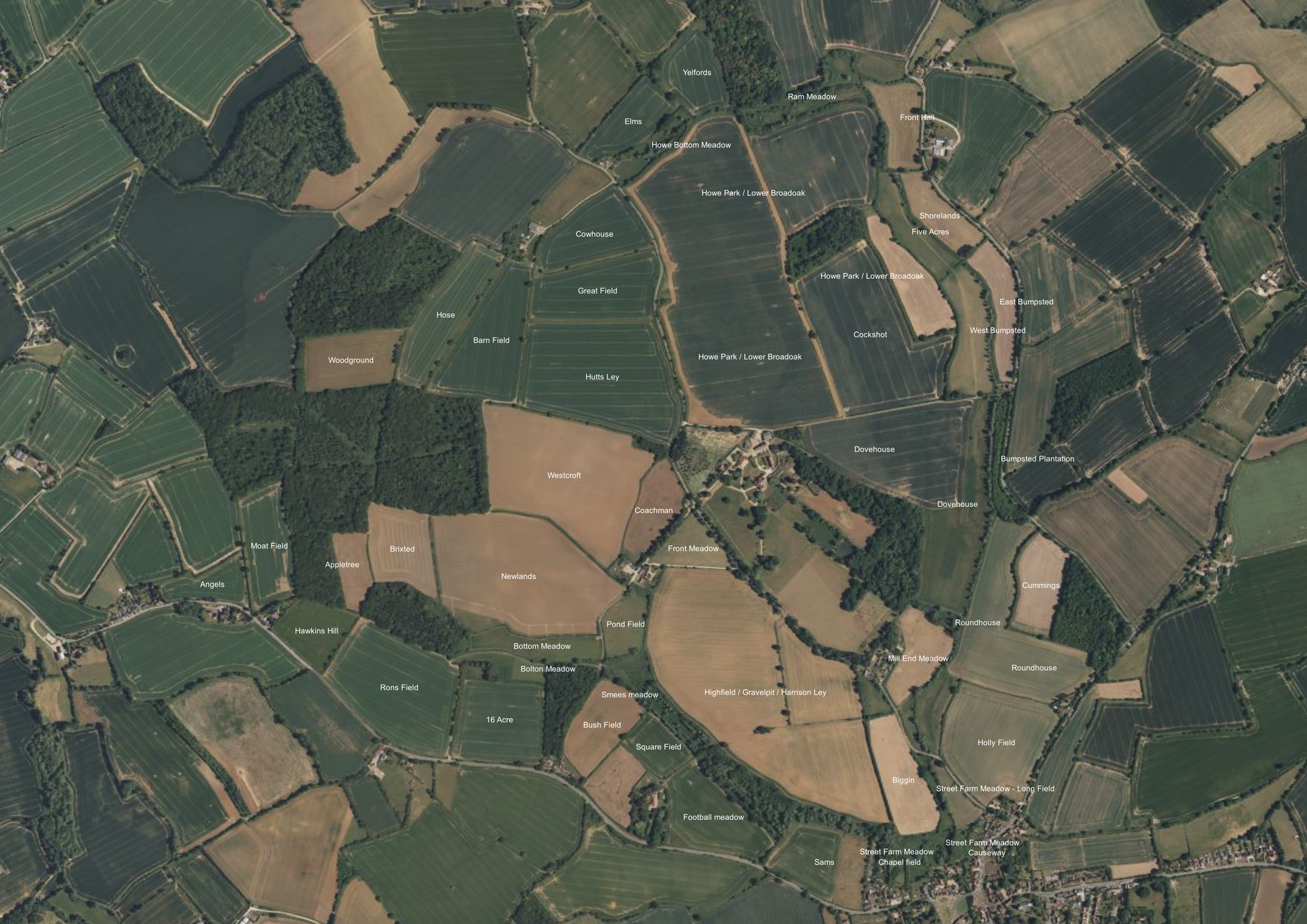

We have BNG Units available. Contact Us
Thank you for contacting us.
We will get back to you as soon as possible. In the meantime why not download our BNG brochure.
Please try again later.
Field transformations
Scroll down over each "field-in-the-future" below to learn more about our plans to transform it for the benefit of the environment and sustainable food production
Click here to download our Nature Recovery & Biodiversity Net Gain brochure
Contact us to discuss working with us to deliver this project
Woodground
As the name suggests, this field was originally woodland on the hand-drawn 1618 Estate map by Pope. Broad-leaved woodland will be created re-connecting County Wildlife Sites Great Howe & Little Howe Ancient Semi-Natural Woodland. The increased connectivity and woodland scale will enable the existing population of Marsh tit to expand their range, which is particularly important given their relatively large territory requirement.
Front Hall
The introduction of Eurasian Beaver will stabilise the brook, by slowing the flow during peak rainfall periods and storing the water during periods of low rainfall or drought. With the increasing water table, natural succession into a wetland habitat mosaic will develop rapidly from the previous arable monoculture.
Roundhouse
The creation of permanent habitats such as modified grassland, broad-leaved woodland, tussocky grass and mixed scrub will prevent future soil erosion and run off down this sloping ex-arable field, whilst connecting ancient species-rich hedgerows and tree lines within the landscape.
The introduction of Eurasian Beavers in 2023, specifically as ecosystem engineers, not only provides a nature-based solution to local flooding by storing water upstream but will also reconnect the ex-arable floodplain with the previously artificially deepened Finchingfield Brook, to create a biodiverse floodplain wetland habitat mosaic.
Biggin
The creation a mixed scrub area at the bottom of this sloping field will connect in beautifully with the existing floodplain meadows and mature trees along the Finchingfield Brook, expanding the existing habitat mosaic and minimising any agricultural impact from the field. The successional area of mixed scrub, rough grass and open flower areas will provide shelter, nesting and a food source for a wide range of species from pollinators, through to small mammals and birds such as Harvest mice and Song thrush.
Whilst this habitat creation is not impacted by any public access, views from a nearby Public Right of Way on higher ground, will enable this habitat and its associated wildlife to be appreciated by the wider public.
Dovehouse
The introduction of Eurasian Beavers in 2023, specifically as ecosystem engineers, not only provides a nature-based solution to local flooding by storing water upstream but will also reconnect the ex-arable floodplain with the previously artificially deepened Finchingfield Brook, to create a biodiverse floodplain wetland habitat mosaic.
The 1618 historic map shows significant tree cover throughout this area. Therefore to restore historic land use and contribute towards a diverse habitat mosaic, mixed scrub and woodland pockets will be created on the land sloping up from the floodplain.
Elms
Long-term grazed wood pasture will be created by the establishment of flower-rich neutral grassland with scattered standard trees and in small clumps. This area already has several mature and veteran Oaks to provide a varied tree age structure so indicative of wood pasture. The area will be grazed as part of a larger grazing compartment with cattle moving between the adjacent County Wildlife Site floodplain meadows and adjoining wood pasture.
Appletree
The linking of two County Wildlife Site Ancient Semi-Natural Woodlands with further broad-leaved woodland creation will increase the capacity to support Section 41 species Marsh tit, which typically have large territories. This requirement means that landscape scale woodland management and connectivity between woodlands is essential for dispersing juveniles and reducing population fragmentation long-term. Both of these factors have been fully addressed within the Estate’s Ecological Landscape Plan.
Dovehouse
The creation of flower-rich neutral grassland with individual trees planted within the sward at a density of 10 trees/hectare, both as specimen trees and in small clumps of 3-5 trees (with underlying shrub species, to create good quality habitat and microclimates at an early stage). The aim is to extend the adjacent BAP habitat in keeping with the historic landscape, providing good quality wood pasture and parkland for future generations.
West Bumpsted
The creation of a Floodplain Wetland Mosaic along the Finchingfield Brook, utilising the engineering skills of the Eurasian Beaver, introduced in 2023.
The creation of mixed scrub and broad-leaved woodland on the ground sloping up from the floodplain, contributing towards a diverse habitat mosaic. The 1618 historic map shows significant tree cover throughout this area of the Estate.
Front Meadow
The creation of flower-rich neutral grassland with individual trees planted within the sward at a density of 10 trees/hectare, both as specimen trees and in small clumps of 3-5 trees (with underlying shrub species, to create good quality habitat and microclimates at an early stage). The aim is to extend the adjacent BAP habitat in keeping with the historic landscape, providing good quality wood pasture and parkland for future generations.
Lower Broadoak
In addition to the historic field name, the 1618 historic map shows significant tree cover throughout this area of the Estate.
The creation of a mixed scrub and broad-leaved woodland habitat mosaic on the ground sloping up from the floodplain, with establishment aided by the adjacent ancient species-rich hedgerows, will restore both the historic land use and a diverse habitat mosaic.
Coachman
The creation of flower-rich neutral grassland with individual trees planted within the sward at a density of 10 trees/hectare, both as specimen trees and in small clumps of 3-5 trees (with underlying shrub species, to create good quality habitat and microclimates at an early stage). The aim is to extend the adjacent BAP habitat in keeping with the historic landscape, providing good quality wood pasture and parkland for future generations.
Mill End Meadow
This low lying area of Mill End Meadow directly adjacent to the Finchingfield Brook, whilst currently agricultural grassland, with the introduction of Eurasian Beavers, specifically as ecosystem engineers, will reconnect the ex-arable floodplain with the previously artificially deepened Finchingfield Brook, to create a biodiverse floodplain wetland habitat mosaic.
This area has good connectivity with other wetland areas and streams on the Estate, including an established beaver - created wet woodland, which through survey work shows Brown Long-eared, Myotis sp., Common and Soprano Pipistrelle along with Barbastelle bat all utilising for foraging trips.
East Bumpsted
The creation of a Floodplain Wetland Mosaic along the Finchingfield Brook, utilising the engineering skills of the Eurasian Beaver, introduced in 2023.
Not only will the beavers reconnect the ex-arable floodplain with the river, storing water upstream to reduce local flood risk, but also create a diverse habitat mosaic of wetland plant species, scrub and trees for species like Water shrew, Common toad, along with birds such as Kingfisher, feeding upon the abundance of aquatic invertebrates such as Damselflies, freshwater shrimps and tadpoles found in the pools.
Holly Field
The annual intensive cropping system is being replaced with an agro-forestry nut system. Between the tree rows are a range of habitats designed to provide year-round habitat for farmland wildlife such as Brown hare, Skylark, Yellowhammer and Linnet.
Habitats include perennial and biannual winter bird covers, fallow, nectar mixes, floristic & fine grass areas, tussocky grass and bumble bird mixes.
Shorelands
The introduction of Eurasian Beavers in 2023, specifically as ecosystem engineers, not only provides a nature-based solution to local flooding by storing water upstream but will also reconnect the ex-arable floodplain with the previously artificially deepened Finchingfield Brook, to create a biodiverse floodplain wetland habitat mosaic.
The beaver trial on the River Otter, Devon, show that beaver engineered habitat increased the number of Common frog pairs from 10 in 2011 to 681 pairs by 2017.
Neutral grassland will be created on the river valley slopes leading up to a broad-leaved woodland creation project following the contours on the higher ground.
Angels
Broad-leaved woodland will be created on this sloping arable field, eliminating any future soil erosion and run-off with a permanent habitat. In combination with Moat field, this creation will also significantly extend County Wildlife Sites Great Howe and Almonds Grove Ancient Semi Natural Woodland, enabling species such as the existing population of Marsh tit (with fragmented populations across Essex) to expand into new territories in time.
Five Acres
The introduction of Eurasian Beavers in 2023, specifically as ecosystem engineers, not only provides a nature-based solution to local flooding by storing water upstream but will also reconnect the ex-arable floodplain with the previously artificially deepened Finchingfield Brook, to create a biodiverse floodplain wetland habitat mosaic.
The introduction of Eurasian Beaver will stabilise the brook, by slowing the flow during peak rainfall periods and storing the water during periods of low rainfall or drought. With the increasing water table, natural succession into a wetland habitat mosaic will develop rapidly from the previous arable monoculture.
Roundhouse
Within the river valley, the introduction of Eurasian Beavers in 2023, specifically as ecosystem engineers, not only provides a nature-based solution to local flooding by storing water upstream, but will also reconnect the ex-arable floodplain with the previously artificially deepened Finchingfield Brook, to create a biodiverse floodplain wetland habitat mosaic.
The increase in dead wood and habitat diversity results in a significant increase in invertebrate abundance and diversity, which in turn provides foraging for species such as the rare Barbastelle bat already utilising the established beaver wetland elsewhere on the Estate.
Football Meadow
The establishment of a structurally diverse successional area along the bottom of this field will not only buffer the adjacent beaver-created wet woodland, and adding to the overall habitat mosaic supporting a plethora of species within this area of the Estate. The structure that develops is a favoured habitat for Section 41 species Harvest mouse, with the scrub providing support for their nests woven from the finer grasses present.
The creation of tussocky grass margins around the remaining field edge will not only significantly improve connectivity through the landscape, but provide excellent small mammal habitat and therefore good hunting habitat for Barn owls.
Yelfords
The creation of flower-rich neutral grassland on poor gravelly ground, along with low density tree planting as single feature trees or in small clumps to establish grazed wood pasture long-term. This area already has several mature and veteran Oaks to provide the varied tree age structure of wood pasture.
The expansion of existing mixed scrub along the Finchingfield Brook and BAP woodland habitat will provide a contrasting habitat structure to the wood pasture. Ponds will also be created to add to the habitat mosaic and support the landscape scale recovery of Protected species Great-crested newt, in addition to other species reliant upon water such as dragonflies and damselflies within their life cycle.
Moat Field
Broad-leaved woodland will be created extending County Wildlife Sites Great Howe and Little Almonds Grove Ancient Semi-Natural Woodland. A wide variety of native species will be planted, in part to reflect the species composition of the existing woodland, but also to minimise disease potential and provide some climatic resilience.
Rides and glades will be created for woodland butterfly and moth species, in addition to ensuring that existing boundary mature Oaks are given enough space to continue their development and ponds created maintain an open aspect, at least on the south side. Woodland will not be planted adjacent to the moat forming the southern field boundary, protecting the archaeological feature from root damage.
Hawkins Hill
The creation of flower-rich neutral grassland with individual trees planted within the sward at a density of 10 trees/hectare, both as individual standards and small clumps of 3-5 trees (with underlying shrub species, to create good quality habitat and microclimates at an early stage) will establish wood pasture for future generations.
The new wood pasture will provide a different habitat structure adjacent to the County Wildlife Site Ancient Semi Natural Woodland, and increase the connectivity across the landscape.
Brixted
This field has the remains of a Roman Villa underneath. To prevent any further degradation from arable cultivations, the field will become neutral grassland, protecting the archaeology and providing a flower-rich sward as part of the overall habitat mosaic.
A permanent cover will also prevent soil erosion down the slope into the watercourse that runs through Long Almond Grove.
Hose
The annual intensive cropping system is being replaced with an agro-forestry nut system. Between the tree rows are a range of habitats designed to provide year-round habitat for farmland wildlife such as Brown hare, Skylark, Yellowhammer and Linnet.
Successional areas (mixed scrub, rough grass, sedges and wild flowers) will be established, primarily through colonisation of species from the adjacent ASNW woodland, species-rich hedgerows and diverse field margin habitat. The creation of permanent habitat will also protect the root balls of veteran Oaks trees present in this area.
This structurally and botanically diverse habitat mosaic will support Section 41 species such as Song thrush, Harvest mouse, Great-crested newt and six bat species, including the rare Barbastelle bat, present on the Estate.
Bush Field
This small field, directly adjacent to a small BAP Priority woodland, is an ideal opportunity for the creation of further native broad-leaved woodland. It will link in well with the successional areas to also be created along the valley bottom, buffering the wet meadows from any further agricultural operations.
Species to be planted include Pedunculate Oak, Field maple, Crab apple, Spindle, Hawthorn and Midland thorn, Wild Cherry, Hornbeam, Blackthorn, Wild Service, Small-leaved lime and Dog rose. In the damper areas, Black Poplar and Goat Willow will be considered.
Great Field
The annual intensive cropping system is being replaced with an agro-forestry nut system. Between the tree rows are a range of habitats designed to provide year-round habitat for farmland wildlife such as Brown hare, Skylark, Yellowhammer and Linnet.
Habitats include perennial and biannual winter bird covers, fallow, nectar mixes, floristic & fine grass areas, tussocky grass and bumble bird mixes.
Hutts Ley
The annual intensive cropping system is being replaced with an agro-forestry nut system. Between the tree rows are a range of habitats designed to provide year-round habitat for farmland wildlife such as Brown hare, Skylark, Yellowhammer and Linnet.
Habitats include perennial and biannual winter bird covers, fallow, nectar mixes, floristic & fine grass areas, tussocky grass and bumble bird mixes.
Westcroft
A successional area (mixed scrub, rough grass, sedges and wild flowers) will be established, primarily through colonisation of species from the adjacent Ancient Semi-Natural Woodland, species-rich hedgerows and diverse field margin habitat. At the eastern end of the field, neutral grassland interspersed tree planting, both as feature trees and in small clumps, will create wood pasture long-term, against the historic backdrop of Spains Hall and other historic buildings.
Newlands
A successional area (mixed scrub, rough grass, sedges and wild flowers) will be established along the southern boundary of the field, linking in with a small existing successional area, and beyond that into Ancient Semi-Natural Woodland County Wildlife Site. This structurally and botanically diverse habitat mosaic will support Section 41 species such as Song thrush, Harvest mouse, Great-crested newt, Barn owl and bat species, including the rare Barbastelle bat, present on the Estate.
Bolton Meadow
Ponds will be enhanced and created within an established damp meadow, adding to the network of ponds across the farmed landscape for Protected species Great-crested newt.
Solomans
Two new species-rich hedgerows to be planted winter 2023/2024 along the historic lines, will once more define this small field within the landscape and reconnect existing mature scrub and BAP Priority woodland habitat. Native hedgerow trees, such as Oak, Field Maple and Crab apple will also be established to further enhance the long-term biodiversity value of the hedgerows. A successional area will be created alongside the northern field boundary, to be colonised from the adjacent scrubby hedgerow. The habitat will compliment the nearby mature scrub and floodplain meadows.
Howe Park
The annual intensive cropping system is being replaced with an agro-forestry nut system. Between the tree rows are a range of habitats designed to provide year-round habitat for farmland wildlife such as Brown hare, Skylark, Yellowhammer and Linnet. Habitats include perennial and biannual winter bird covers, fallow, nectar mixes, floristic & fine grass areas, tussocky grass and bumble bird mixes.
Two new species-rich hedgerows to be planted winter 2023/2024 along the historic lines, will split up this large, open field and increase the connectivity within the landscape. In addition a new native broad-leaved woodland will also be planted on the historic footprint, extending the existing BAP Priority Woodland.
The restoration of an existing historic pond, combined with the opening up of a ghost pond for Protected species, Great-crested newt, and other aquatic species, linked by hedgerows and margins, will complete this diverse habitat mosaic.
Cockshot
A new species-rich hedgerow to be planted winter 2023 along the historic line will redefine this field within this very visible and open landscape, in addition to connecting habitats such as woodland and wood pasture long-term. Mature Oaks are already present along the historic line. New native trees will also be planted into the hedgerow for succession purposes.
The hedgerow will be buffered by floristic margins. Section 41 species Yellowhammer select territories with access to field margins, particularly when floristically enhanced, with chick-food insects been more numerous than in other habitat types.
A successional area will be created at the bottom of the slope and will gradually be colonised from the adjacent mature, existing, native species-rich hedgerow.
Highfield
A Traditional Orchard is be re-created on the historic footprint, with neutral grassland and the planting of Heritage fruit tree varieties from the local area such as Braintree Seedling (a desert apple).
Wide tussocky grass margins will be created alongside the newly planted hedgerows, dividing this large field back into three distinct smaller fields - Gravelpit, Highfield and Harrisons Ley. The tussocky grass will provide a wildlife corridor for movement across the landscape, in addition to excellent nesting habitat for Section 41 species Harvest mouse, along with iconic farmland bird species Grey partridge.
These margins will also make excellent habitat for other small mammals species, such as Bank vole, Common shrew and Wood mouse, which in turn will be provide prey items for the Barn owl pair living in the barn next to the field.
Rons Field
The annual intensive cropping system is being replaced with an agro-forestry nut system. Between the tree rows are a range of habitats designed to provide year-round habitat for farmland wildlife such as Brown hare, Skylark, Yellowhammer and Linnet. Habitats include perennial and biannual winter bird covers, fallow, nectar mixes, floristic & fine grass areas, tussocky grass and bumble bird mixes.
Along the base of the slope, a successional area of mixed scrub, rough grass, floristic areas and occasional trees, will be established, buffering and enhancing the adjacent Ancient Semi-Natural Woodland County Wildlife Site.
